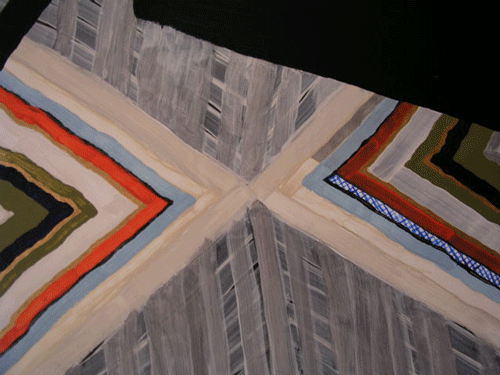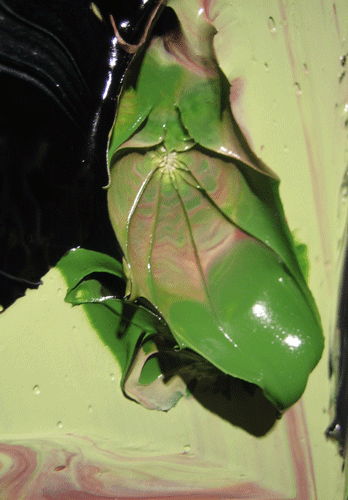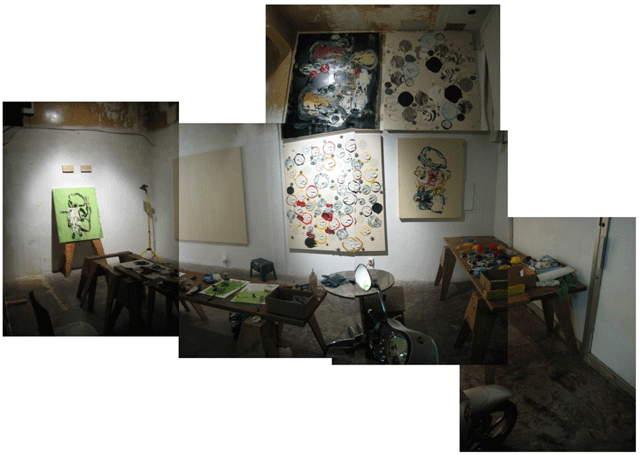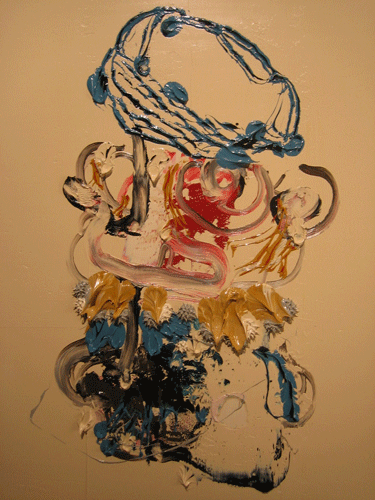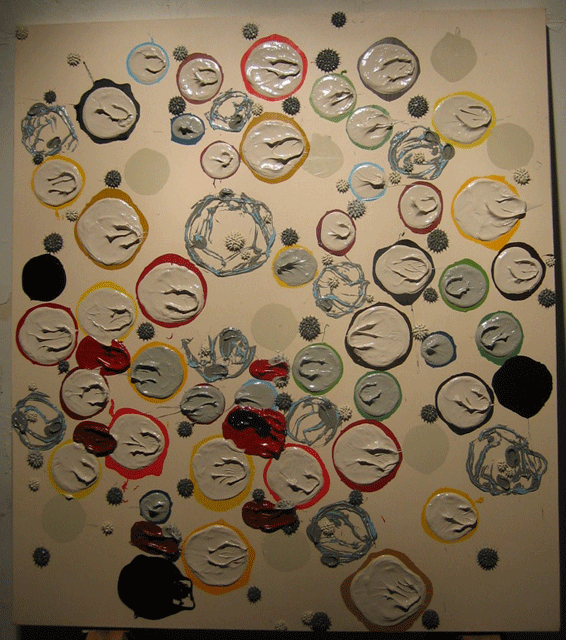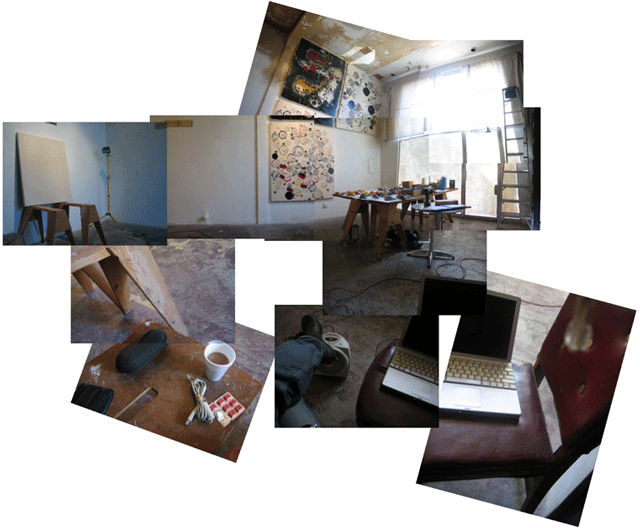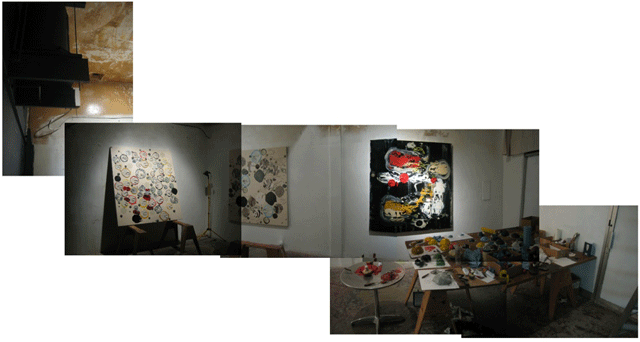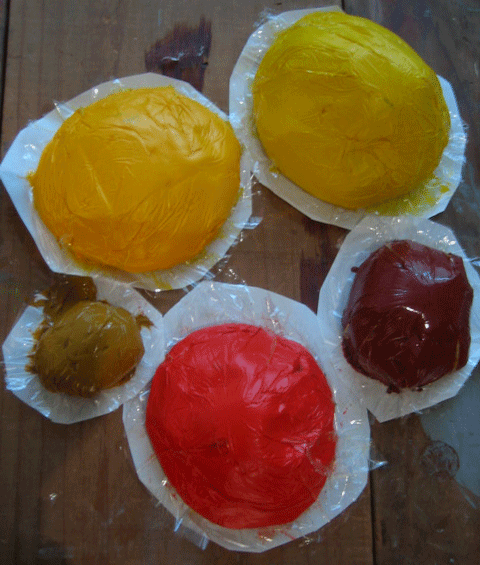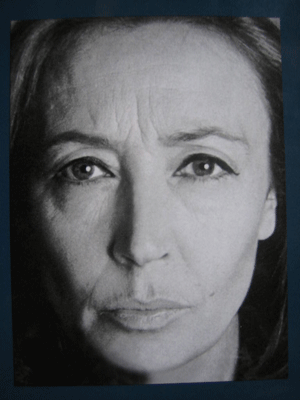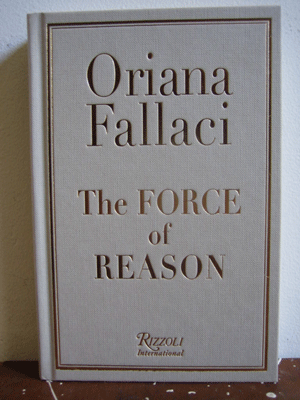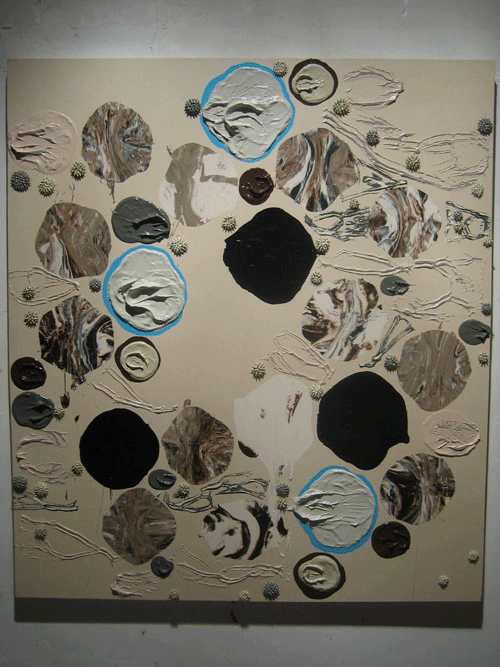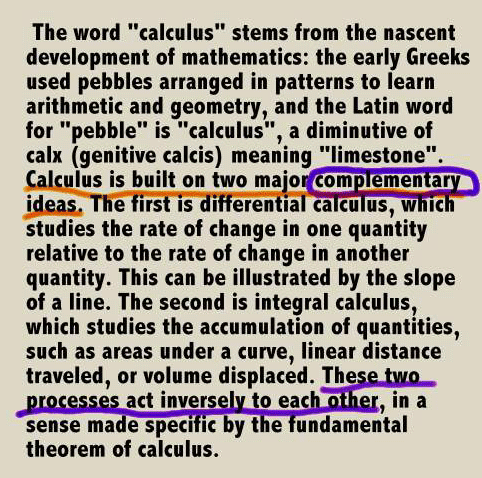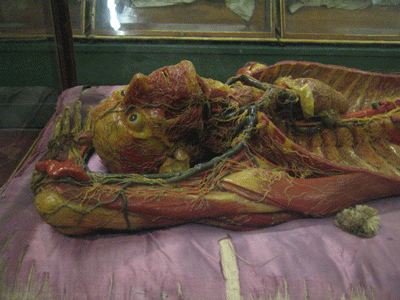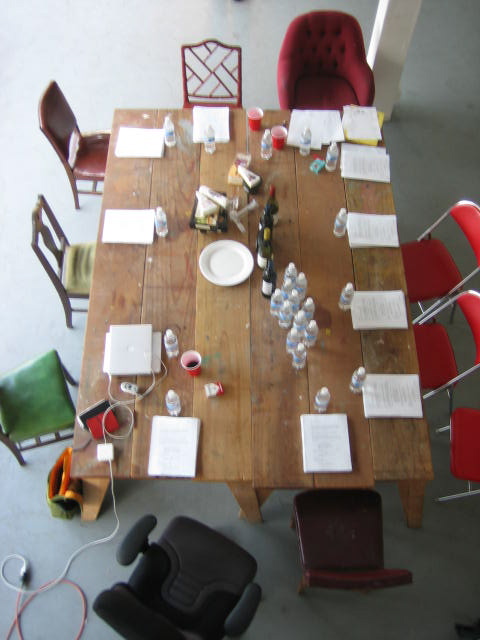March 31, 2006
Allison Miller at Bart's Place
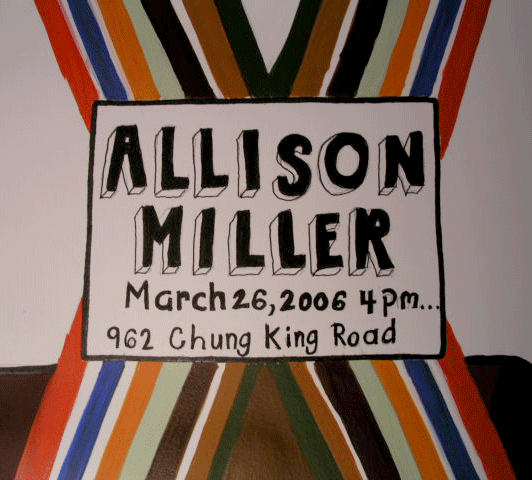
Bart Exposito had another opening for a one-day-show on his one-wall-ocassional gallery, the big and biggest wall in his palace of a studio on Chung King Road.
Altruistic, he is.
This time, Allison Miller is on deck.
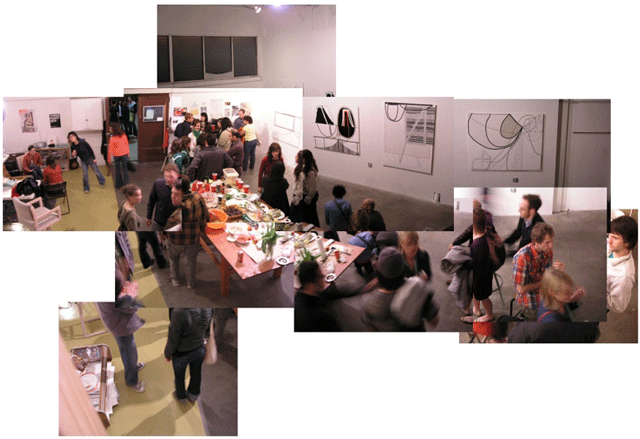
I heard that Allison is an artist a few years out of school and that she was amassing interesting work away from the hubub of the art scene machine hustle.
Bart felt her work needed to be seen, therefore this show.
***
SIDENOTE:
Kismet follows its' own rule, People. So please don't bug Bart for a show. Bart isn't running a gallery.
Thankyouverymuch.
***

There's an notion in the air that the whole idea in and around exhibitions in our art world is totally (vernacular engine deployed) up for grabs whether it be putting out announcements and leaving it at that, dethroning the formality of presentation, flexing ideas for what physically constitutes an exhibition space, detaching propietary agency from location (the virtual, thus portable nature of a branded identity)... I could go on but I don't feel like essayin'. (vernacular engine off.)
(I was going to go off like this: "The deal is that you've got to protect some animating spark, a kind of soul of art itself however variously embodied in an artworld. Ideas come and go and most times the test of the potency of an idea is whether it can sustain the energy needed to mount a show. Against this, a ponderous wolrd of..."
-then I thought better of it. Let's return to Allison's paintings.)

Squares and lines and stripes and landscapes like Hockney and dazzling eyes like Peter Max and Matt Groening robot surveillance eyes and vortexes and all those monochrome dyptich guys and that guy at Blum and Poe who paints kaliedescopic vortexing geometries and prayer shawls and stuff.
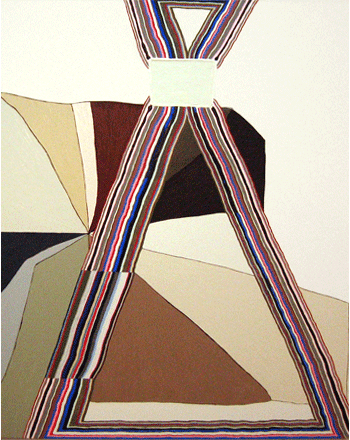
This is the painting that Bart copied for the announcement. Inspired, he was.

Lasker. I feel all Laskery. I've got that Lasker feeling.
I wonder how she is approaching her paintings.
Lasker's peculiarities come from stationary store media (markers and index cards). A displacement tactic like fotos displace paint in Richter. Or is she direct in relation to her composition the way my friend Joanne Greenbaum is doodling on the grandiose scale of big art . (A shout out to you, Joanne! Only good intentions here with the doodle reference!) Or does Allison do a displacement tactic like Jeff Elrod does: computer to paint, a Richter on steroids in that way (fotos as they were -chemical emulsion are flat inert 2D surfaces, an artist scales up with grids or projects the image to scale up... when a foto is digital, pixels are assigned through software, a substrate that is an architectural empire of information.
I feel all Agnes Martiny now.
(It's interesting to compare this detail with the detail of Bart's announcement at the top of this blogpost. )
March 30, 2006
Hello Trudy!
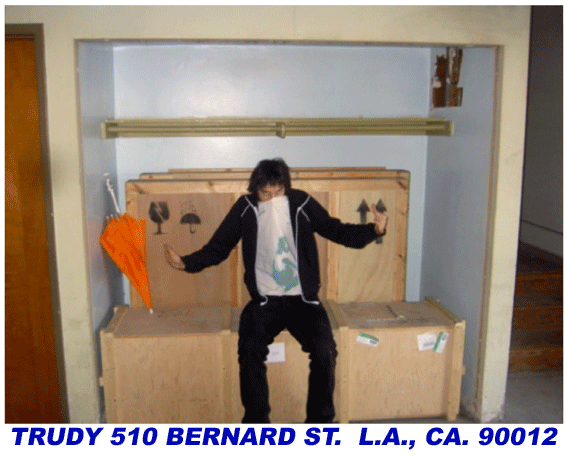
There's a new gallery in town.
Matt Chambers is going to open TRUDY, the fourth gallery at the ChinaTown cul-de-sac, 510 Bernard Street. Matt is the guy who makes events like this happen. The inaugural show will feature "Couch Paintings". More blogposts on this later.
Modalities
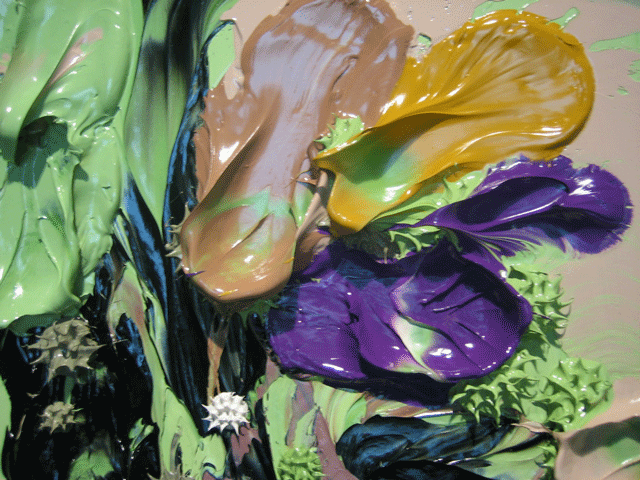
Let's take a look at the latest:
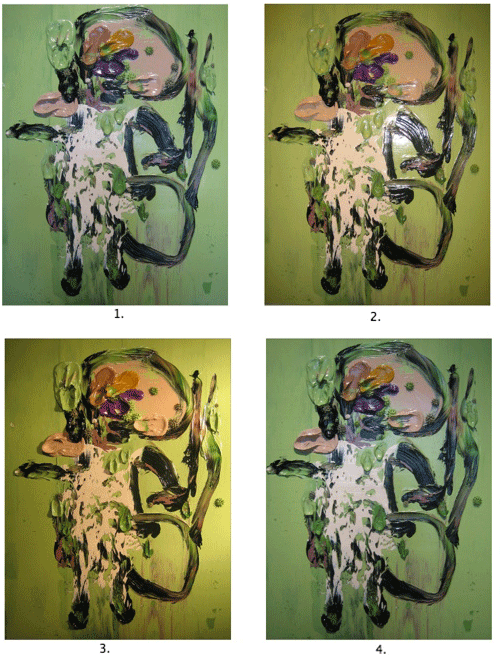
Various Lighting Conditions:
Early Morning Light, Springtime LA.
South Interior Studio Wall, North Facing Window.
Two 300 Watt incandescent Floods Eight Feet Above and in Front.
1. Curtains open.
2. 500 Watt Task to the Right, Flash, Curtains Closed.
3. 500 Watt Task to the Right, No Flash, Curtains Closed.
4. Curtains Closed.
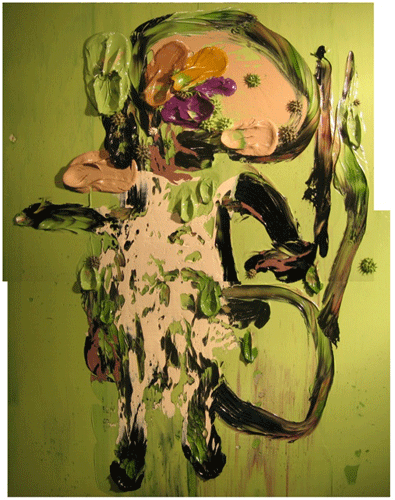
Mapping.
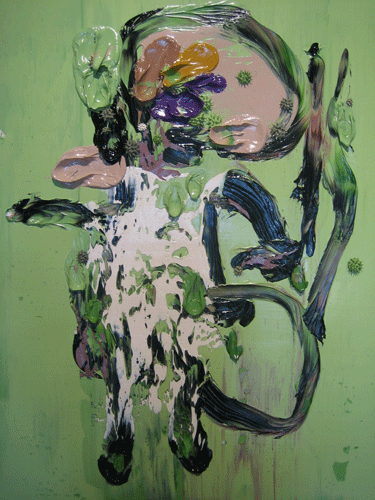
Standard Shot.
What happened:
Four passes followed one after the other, each touch false, one after the other hitting flat notes as I tamped down my frustration along the way. Each time, a new skin was floated over, obliterating the aborted attempt, forming new strata of pigment, a sacraficial monochrome base becoming evermore fat and colorfully complicated.
At the end of a day of this, my final hours ticking away with a stopping point looming, I began to think as I loaded my tools with the remaining batch of mixed green paint: "Last chance. Will I get it this time? Or will I have to go home with a mess in the studio to be aborted when I walk in the next morning?"
And then hard black lines went down, driven by purposefully vague figural directions, skipping one schema and opting for another in mid stroke. It finally felt/looked good. This, I know the instant it happens, hands full of loaded tools. Then, I prepared a knife with the last of the batch of warm creamy white... then a flash (!) and every joule of energy spent in applying the tool was right, good, the sweet spot.
I worked all day for that brief moment. And what was good, was also primitive and undeveloped. Every subsequent action had to preserve that grace and build upon it in a way that accentuated what was special about the painting in the first place. This took me another day to bring it all home.
Time to move on.
March 29, 2006
Ahora
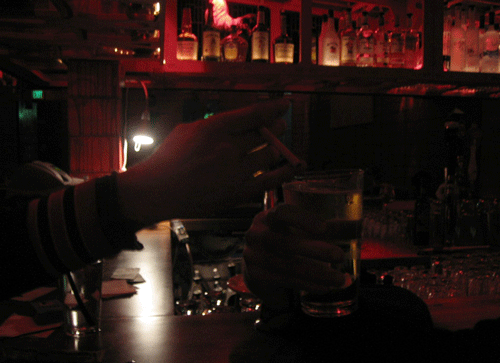
The pirates kidnapped me.
One drink I said.
Two.
Three, we were toasting L'Chaim.
Back to the studio before eleven.
March 28, 2006
March 27, 2006
Is Gewein A Folk

Studio Music Report: a current favorite from Massel Klezmorim.
Especially song number 9, "Un as der Rebbe sint", a song I can barely decipher but I think it is one in which a Hasidic Rabbi is called upon in turns to sing, to sleep, to laugh. The singer, Elias Lutz, sings and snores and splits his guts in belly laughs slow and fast in turns yelling "Ho-Paaaaa!". Hilarious. There are no lyrics but here are the liner notes for this song:
At this time, many stories were told about miracles done to Rabbis, like this one for example:-At school, the Rabbi tells a story of Rabbi Schloime (Salomo), to whom God had done many miracles: "One day, Rebbe Schloime walks through the wood and finds a foundling under a tree. He raises his hands, sings and prays that God might do a miracle, so that the child can survive. And, I tell you, God does a miracle and makes breasts grow to the Rabbi Schloime.
"Chaim, what's on? Are you laughing about God doing a miracle to the Rabbi Schloime?" "Well", says Chaime "I ask, why do a miracle, if the same would have been done with a little cash?" "Well", says the teacher "this is right, but I think, why take the good cash, if it is possible with a miracle?"
JUNGLE PATROL
Take care, people.
This blogpost has the capacity to take you down a GIGANTIC FILIPINO WORMHOLE!
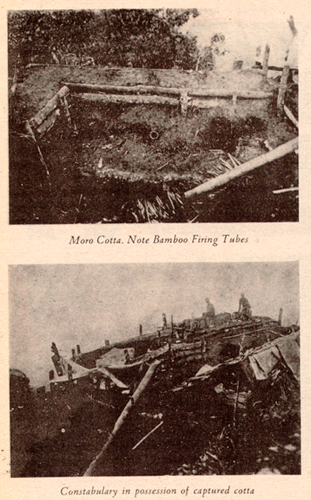
The year 1906. . . .Commanding officer's quarters at Pettit Barracks, Zamboanga.
General Leonard Wood penning a note to Colonel J. W. Duncan of the American assault forces. "I wish you would get two of your companies together and go to Jolo at once. Nothing but blanket rolls, field mess outfit, seven days' field rations and two hundred rounds per man. In haste. Regular orders will reach you later."
The storming of the cottas on Bud Dajo . . .
Up the steep sides of the mountain, American soldiers advance against the frowning cottas, garrisoned with 1,000 armed Moros. Nine hundred and ninety-four Moros fall before the Gatling guns of the twentieth century. The trenches are piled high with the slain. Kris against Gatling gun. Spear against mountain artillery.
Civilization marches on. . . .
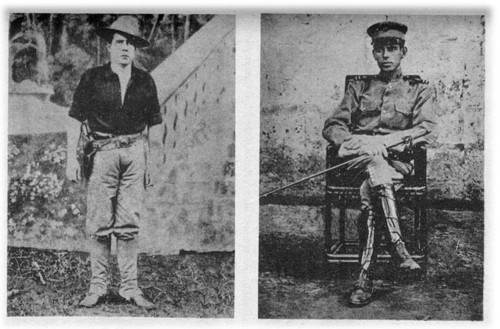
About three months before Wretchard of the great GWOT analysis blog Belmont Club had flagged the website featuring Jungle Patrol (please read his introduction to Victor Hurley's Jungle Patrol, it is superior to what I can do here), I surfed into it over the past Winter holiday. I have always been searching for the nature of my mixed heritage. While we are awash here in the States in information regarding our nature as Americans (North Americans, Yanks), there is precious little to be found regarding the Filipino people.

(Note: For those of you who don't yet know, I am heterogenaic. My father was born in Texas and raised in Missouri; my mother was born in Quezon City, and raised partly in Manila and in Madrid. I was born in Madrid when my folks met there many moons ago. I'm a half breed, a mestizo, a member of the mongrel race and proud of it.)
I used to go to cultural center in Manila when I was a kid sailor on leave and I remember coming away with little to edify me as to who were the Filipinos before the colonialization of the USA or of Spain. The CIA FactBook lists the ethnic breakdown this way:
Tagalog 28.1%, Cebuano 13.1%, Ilocano 9%, Bisaya/Binisaya 7.6%, Hiligaynon Ilonggo 7.5%, Bikol 6%, Waray 3.4%, other 25.3% (2000 census)Or another way to see the bewildering diversity of the Filipinos is to count the languages: asdie from Tagolog and English, there are eight other dialects.
Later in the early days of our life here in LA, I met a friend of Manuel Ocampo at a cafe in SilverLake. Filipino and a man of years as apparent wisdom, i asked him the question that has been on my mind for most of my life: Who are the Filipinos before the Spanish and the Americans? He told me in sage tones, nodding: "They are a noble race, a very noble race."
Not much help there.
Enter Bakbakan, a Filipino martial arts site:The religious, spiritual and fraternal heritage of the Philippines is evident in the symbols and rites adopted and practiced by Bakbakan International. The values and principles of Bakbakan International, following traditional, regional and Katipunan conventions, are evident in the ritual order in which members pledge their allegiance, loyalty and obedience to God, to country, and to the brotherhood.
What's supercool is that this site features two books that get to the cultural roots issue through links like these: (scroll down on the left margin toward the Histtorical Features category) "The Burning of Samar", "Andres Bonifacio", "Captain Leonard Furlong" (a movie should be made of this guy), "Swish of the Kris" (kris is a type of fighting blade), and the one featured here in this blogpost, ""Jungle Patrol".
What follows are snippets for your perusing pleasure. From Chapter 13, "Mohammedans". Teh point of my post titled "1786" is to say that this Global War on Terror is not new, that it has been with us (USA us) since the founding of our country, and with civilization since we have had one (dates of origin vary). Here in "Jungle Patrol", one might see these roots in the Philippine-American War.
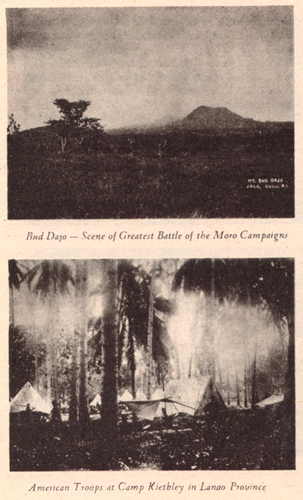
In the vicinity of Zamboanga, the Constabulary was com posed of equal portions of Moros and Christian Filipinos. It was necessary to establish separate messes in each company, as the Moros were forbidden by the Koran to eat pork. This ban prohibited the old army stand-by of pork and beans, as well as the issue of hardtack, which contained lard as an ingredient.The Moros came slowly to the Constabulary. By the end of 1903, one hundred and two of the Mohammedans had been enlisted.
The greatest problem of the authorities was that question of the feasibility of arming these wild Mohammedans with rifles. The Moro youth purchases his bride, or brides, from the father-in-law, the desirability of the maidens influencing the purchase price. It was pointed out that a rifle was an object almost worth its weight in gold in the interior mountains, and that many young Moros might enlist with the idea of prompt desertions with their arms
But the Moro has a peculiar, inflexible code; once he became accustomed to military discipline, he proved a loyal soldier, and desertions were almost zero in the force after organization was complete. Captain Harbord deserves great credit for the tact with which he explored this dangerous possibility.
Harbord made an effort to understand Moros, and he learned many things about these strange grim men.He discovered that to change officers too often was to affect discipline. The Moros made a personality out or their officer; if he was brave and fair, they idolized him for those two prime virtues. Officers had to be especially strong in those qualities of leadership and valor.
Behind that type of officer, the Moros would go smiling and happy to their deaths.
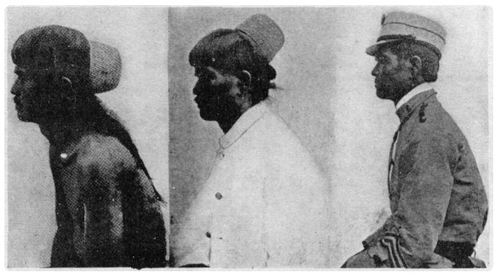
***
On Basilian Island, a station was established at Isabela. Here, Captain Sandford, with 49 men, occupied the old Spanish fort that was a relic of the unsuccessful days of the conquistadores. On clear days Sandford could almost look into the bastions of the old fortress of Senora del Pilar at Zamboanga, fifteen miles away.In Cotabato Province, 95 men under Captain Long were occupying stations at Cotabato, Libungan, Tumao, and Taviran. To this sector came two raw young officers who were extremes in temperament, nationality, and appearance. Lieutenant Gilheuser was one, a big blond German, fresh from the Prussian army.
The other was a slim, dark American boy, very carefully groomed and sporting a tiny mustache. As one considered his slight frame and slender wrists, he seemed ill-adapted for service in this organization of rough fighting men who took jungle in their stride.
But he was to develop--in the opinion of many--into the greatest warrior of them all. His name was Leonard Furlong. His short, wild life must have been an unhappy one. There could have been no other reason for that dashing, frenzied career of battle that he waged in Mindanao.
Twenty years after Furlong had fired his last shot, this writer stood with wrinkled and ancient Moros on the sites of some of the Cotabato battles of this Captain of Constabulary. We talked, the Moros and I, of those old days of murder and piracy and ambush, when the kris had been the law and the measure of a man. The Moros are always ready to talk of battle.
These scarred old reprobates with blackened teeth and betel-stained lips, were no exception. Our conversation that day was filled with grand names: Allan Fletcher of the Scouts, called "Papa" by Moro and Filipino and American--a grand campaigner; Lieutenant Whitney of the prodigious strength gained a shuffle of bare feet and the twitch of a turban; then we talked of a Lieutenant named Cochrun--"a brave man, si," was his accolade; a youngster's name came into the conversation--Jesse Tiffany. The Moros fought him on their cotta walls. He, too, was valiant--a nod of the turbans confirmed him with the greatest praise a Moro can bestow on a man.
But when I mentioned Furlong, a glisten came into the eyes of ancient Moros who talk of redder and grander days. They sent up the most impressive salute to Valhalla that I can ever hope to witness. I see them now as I write--a circle of genial old ruffians, almost ready themselves to mount a white horse to Paradise. Their turbans are off now and their chins at rest on their scarred and brawny chests. After twenty years, they bend a neck to the memory of Leonard Furlong--"most desperate fighting man of all."
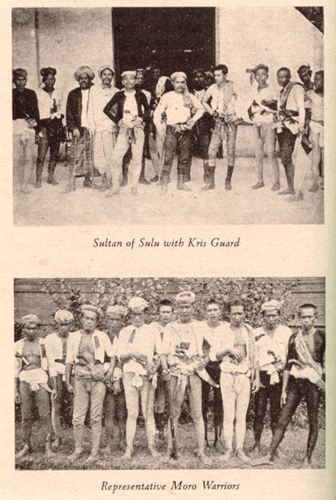
***
No visitor to the southern islands can remain long unaware of the brooding presence of the old forts of Spain. They were abodes of horror in the old days, and they seem to retain those memories of retching death on the kris. These great thick walls and towering bastions were a gesture of futility--a gesture of the Spanish occupation of Moroland.The Spanish fought a waiting war against the Moros. Their indecision developed into the most lengthy wait of history. For almost four centuries they cowered behind walls of stone. The Spaniards took up the Moro wars with a great confidence and a brave flutter of pennons. They dropped the conquest with a feeling of apathy and stark fear.
Only in Mindanao, of all the world, did the Spaniard of the looting age fail to make conquest. There, the conquistadores met men who considered warfare one of the major pleasures of an otherwise drab existence. They met Malays who struck with ferocity and withdrew silently through the tall grass. They met men who were inspired by a major defeat, and who deliberately prolonged the warfare for the sheer joy of fighting.
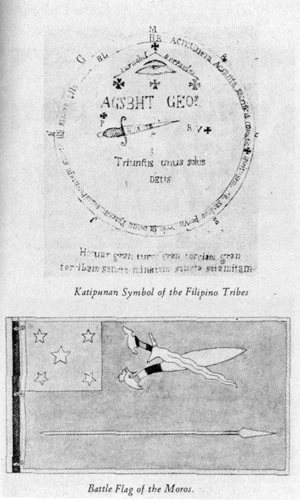
***
This snip is from the "Swish of the Kris":
Mohammedan conquests from Arabia reached India and Sumatra about AD 700. Thence the religion spread slowly across the Netherlands East Indies to envelop all of the islands of the East Indian Archipelago. Sumatra was converted by 1200, and Java came under the influence of Islam by 1500.It appears that in the year 1380 the first Mohammedan missionary, a noted Arabian judge named Makdum introduced the religion to the Philippines. The ruins of the mosque he built at Tubig-Indangan on the island of Simunul are still to be seen.
Later, about 1400, the Rajah Baguinda continued the work of Makdum. The remarkable campaign of this missioner ended on Sibutu Island where he lies buried today in the village of Tandu-Banak. The work of Baguinda appears to have been confined to the islands of the Sulu Archipelago. To Shereef Kabungsuwan is credited the conversion of Mindanao.
The followers of Mohammed were zealous in spreading the faith. They conquered Asia Minor and Africa. Then the robed priests entered Europe, first by way of Spain and through the Red Sea southward to Madagascar and eastward to India. No hardship was too great, no people too savage. From India, the Star and Crescent were carried to the Malay Archipelago. A Mohammedan settlement was established in Borneo as early as 1400, and Malacca was penetrated in 1276. The Portuguese Moluccas was converted by 1456.
The early Mohammedan missionaries were a sturdy lot. They came into raw countries without ships or armies or governments to back them. They must be numbered among the most sincere disciples that any religious faith has produced. They sought nothing but the privilege of converting the unbeliever. Gold they wanted not. Trade routes were not the object of their search. They came alone into the heart of one of the most savage countries on the globe, buoyed high by a faith which protected them well.
They had all the fanaticism of the Spanish priests without the accompanying greed for gold. They were the most purely altruistic preachers in the world. Their utter sincerity inspired the confidence of their savage hosts. The priests of Mohammed were among the most potent spreaders of civilization in the history of man. Their religion did not tear down and strip and destroy as that of the early Christians. The priests of Mohammed brought culture and writing and the arts, and they added these things to the culture they found in their new lands. They were not destroyers, but were satisfied to improve the old culture.
And so to the island of Simunul came the missionary Makdum in 1380, to land unarmed and unafraid in the group of brown krismen who came down the strip of white beach to meet him. The Moros were puzzled and in awe of this man who came unannounced among them, asking nothing but the privilege of being heard. The iron of the Koran had arrived to fortify the souls of the Moros.
Through the islands spread the word of the man who told of the true God and of the warriors slain on the field of battle, reclining on damask couches with houris with "large black eyes."1
POSTSCRIPT: Rereading this post, I have a second thought about the characterization of Jungle Patrol and the Philippine-American War as a solitary index to the character of Filipinos. The culture described here is Moro, something I know little about (familialy or otherwise) first hand. There is something about the tribal legacy that infuses the many islands of the Philippines... but ultimately this is too ephemeral for use as a cultural marker for what I am seeking.
Therefore, I keep on seeking....
Modern Again and Again
I slipped an architectural undergraduate degree in place of where an art undergraduate degree is usually situated in the resume of today's artist. Possessing analytic and synthetic architectural (mental) bones is the obvious upshot... on the other hand, I had applied a do it yourself approach to garnering art school fundamentals. The fine points of art material handling technique aside (sat aside such as it is in most of today's art schools), I am (acutely?) aware of how I see the Modern differently from most other people.
So naturally, I perked up as I scanned the recent offering from Arts & Letters Daily, Robert Hughes brings us up to date on the evolution of the meaning of this heavily frieghted word here in the Guardian Unlimited:
Modernism is a weasel of a word, whose meanings slip and slide. They always have. Not that one should use "modernism" and "always" in the same sentence. Nobody talked or thought about modernism in the middle ages - the idea of a battle between "new" and "established" cultural forms was not an issue then. Now it has gone completely the other way. Nobody, or nobody with brains, assigns a missionary role to culture. The work of art is just one more consumer product among others.
(Hmmm... that last sentence bugs... if it is just one more goodie in the markeplace, it is at least one whose value as a consumer product is judged by an estimation of its' intrinsic value in light of an evolving art history... which makes it at least... exceptional... among other consumer products.)
I'm not exactly sure how Robert Hughes is regarded by the poohbah egg heads of our artworld today, but let this blogpost fly his flag high. The picture he presented in Shock of the New meshed very well with the one presented in my architectural history classes and I have yet to encounter a serious alternative history of the emergence of the modern that punches at his wieght. (If you know of one, dear blog reader, please tell me! I'd like to know of it.) Reading his Barcelona upon our arrival in Catalunya was critical for a deeper understanding of Gaudi and Catalan culture. I'm a fan.
Years ago, first in art grad school and later as I taught archtiecture, that people were generally unable to supply a cogent general definition of the Modern, and therefore much, much less the PostModern. How should anyone be allowed to pontificate on PoMo when Mo is too fuzzy to describe? Allow me to tame the weasel with (my) definition of the Modern:
To be Modern is to reconcile the things one makes with the life one is living.
Caveat: This blogpost is dangerous for me since a full treatment on the subject of the Modern compells a hefty essay with swift currents that will draw me towards months of writing. I respect writing so much that I acknowledge that my work here in this blog to be more akin to scribbling, jots and notes made in haste, not even a journal, less than a diary. So with this escape clause in hand, please allow a series of bullet points to dress out this subject, so I can properly get back to painting:
-The Modern Age was ushered in with the acceleration of technological change in the early 19th to 20th centuries. The crisis for creative folk was to contend with this change, to deal with: the stress of it, to accomodate the new artifacts that were/are reordering life, to give form to revolution in its many manifestations, to explore the consequences of change in the excitement of its' thrall, to manage the dangers of it as well...
-Technological change spreads ripples of social change in it's wake. Therefore: friction is normal in Modern life. The ability to adapt successfully to change is critical for our survival.
-Technology is related of course to science and science rests on an absolute freedom of inquiry. Freedom is therefore an absolute value and individualism is a core concept. The ability or willingness to isolate an individual from its' context is essential for science and technology... we should also be mindful to this as a blind spot in our worldview: our ability to forget how things go together.
-When the Modern was born (and I'm thinking of Shattuck's The Banquet Years) the distinctions we make between the Modern and Post Modern not only did not exist then, but each was implicit and explicit in turn. Chris Burden and Paul McCarthy are sons of Alfred Jarry's pistol shot.
-(THIS IS A BLOGPOST DESTINED TO BE IN PROGRESS FOR SOME TIME)
Chris Jagers weighs in:
Dennis,You may already know these books/essays, but I thought I would offer them up in regard to your recent (difficult) topic
Kirk Varnedoe's "A Fine Disregard"
Ive Allen Bois "Painting as Model"
Dave Hickey "Prom Night in Flatland" essayGood luck with your quest. I'm not sure a clean version of history could ever really exist however. MOMA tries to do it, and it always bothers me.
Chris
Yes of course! I agree that a clean version, like utopia, is impossible and perhaps undesireable. Although, I've always sought a way to express what I see from my vantage point, as a way to say: this is what this looks like, do you have another? Shake me up. Show me another view.
Chris' recent blogpost "Flamenco" is another take on Modernity as "Modernismo". A snip from his snip:
"Flamenco is fundametally a solo form, a structured improvisation...it is both traditional and personal, but above all, distilled - brief and heroic, like a speech by someone in the Iliad who is about to die."Our age of the anti-hero might frown on this, but I still value structured improvisation as I hope you might see in my paintings... A mix of the traditional and personal could be thought of as an embodiment of this blog... I think the Iliad rocks (I'm getting jazzy here, sorry).... and in a way, paintings and this blog too, are messages in a bottle for generations after ours.
?Como no?
March 26, 2006
Paul Berman on Francis Fukuyama
I read everything Paul Berman writes:In my view, we are seeing the continuing strength of 20th-century-style ideologies right now ? the ideologies that have motivated Baathists and the more radical Islamists to slaughter millions of their fellow Muslims in the last 25 years, together with a few thousand people who were not Muslims. Fukuyama is always worth reading, and his new book contains ideas that I hope the non-neoconservatives of America will adopt. But neither his old arguments nor his new ones offer much insight into this, the most important problem of all ? the problem of murderous ideologies and how to combat them.UPDATE: This line is worth snipping too:
Nowadays, if you are any kind of political thinker at all, and you haven't issued a sweeping denunciation of your dearest friends, or haven't been hanged by them from a lamppost ? why, the spirit of the age has somehow passed you by.
LAST UPDATE: Charles Krauthammer follows up:
And thus did Francis Fukuyama become the world's most celebrated ex-neoconservative, a well-timed metamorphosis that has brought him a piece of the fame that he once enjoyed 15 years ago as the man who declared, a mite prematurely, that history had ended.A very nice story. It appears in the preface to Fukuyama's post-neocon coming out, "America at the Crossroads." On Sunday it was repeated on the front page of the New York Times Book Review in Paul Berman's review.
I happen to know something about this story, as I was the speaker whose 2004 Irving Kristol lecture to the American Enterprise Institute Fukuyama has now brought to prominence. I can therefore testify that Fukuyama's claim that I attributed "virtually unqualified success" to the war is a fabrication.
Admin
So what is it all about with this blog entry?

I was seized with the desire to shoot head shots of my friends randomly and tag each one with their name and post it straight faced here in the blog. Why? Do I need to explicate more? (See Gold Hat's quote here.)
I think of movie/television credits. It's the Dennis Hollingsworth blog, co-starring...."
Let this be the boiler plate for every time I bust this move.
Checking Breaking News: Paris
A young American art dealer who owns a new gallery in Paris was visiting ChinaTown LA in the past week. A friend of friends, I was delighted to meet him and over coffee, I asked about the disturbing news that I have reading about of the protests/riots in France. In particular I referred to....
...non-integrated immigrant (Muslim) youth from the banlieus rioting, burning cars in protest over the cartoon controversy recently (check this out, via Eric Savane and Labaf), the recent kidnapping and torture of Ilam Halimi, the subsequent protests against anti-semitism (the single hopeful sign), and now the rolling and roiling protests by university students against Villepin's new law -recently ushered under the table- which is designed to ease the soaring French unemployment situation (figures vary: 12% nationwide, 24% for youth entering the job market, such as those students, and up to 50% for the ethnic underclass ghettos in the banlieus).
Therefore, I was eager to get a first hand report from a Yank living in the heart of Paris. His reply: a Gallic shrug. "The French love to hold street rallies. It's a party for them. They do it all of the time."
So, I was a bit perplexed. The news is cascading from the entire political spectrum with reports of economic and cultural problems in the EU. We had seen enough indications the foundations of it when we lived there (for example, the byzantine bureacracy both private and public among other things). Since our dream is to live both in the States and in Europe, predictions of doom for the European continent literally hit home for us.
It was about the mid ninties that I ceased reading the major newspapers in favor of surfing for news online. Regarding our own street protests ...LA had one yesterday... I trust Mickey Kauss' take (via Instapundit), especially his critique of the LATimes' coverage. Gone forever is the sense of being able to rely on mainstream media for my news... and the skepticism remains in traces even now as I gather my new-news from diverse sources. My informational self reliance can't deliver a self assured self confidence in what I am sourcing. So still, I wonder: just how bad is the situation in the EU? How bad will it get?
I see more pictures.
The image at the top of this blogpost was culled from Drudge, who then found it from the source I cited here. It's a beautiful picture: defiance of humanity against a presumable inhumanity. Elegant. A fine large and stylish watch next to a fashion sleeve from a presumably fine outfit. Manicured nails. Muscularity from gymnasia workouts or outdoor sport recreation. Orange smoke in the background reminds us of other contemporary revolutions. Appealing, yes. But look at the other photographs.
How about this:
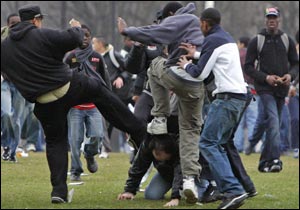
This one is from The Sun:
BRITONS have been warned: Stay away from riot-torn Paris.Further down in the article:
The Foreign Office says the French capital ? which has been rocked by violent demos ? is too dangerous.
The Foreign Office alert is a huge blow to France, which has always considered itself a haven of fashion chic and culture.It's an article well worth reading in full -but even so, there's something lacking. Surfing further, I found this riveting testimonial from Claire Berlinski for the Washington Post:Pictures flashed around the world show a new Paris racked with class division. That was illustrated yesterday by photographs of an elegant woman in high heels set upon by youths in the trendy Esplanade des Invalides...
Some hotels around the famous Left Bank of the River Seine ? usually full of romantic couples strolling hand in hand ? have boarded up their windows up as armoured vehicles with water cannons patrol the streets.
Last Saturday morning, needing help to move several heavy cartons of books from my apartment in central Paris to a storage room, I hired two movers and a van from the want ads. Students were in the streets protesting the Contrat de Premier Embauche (CPE) -- a law proposed to combat unemployment by giving employers more flexibility to fire young employees -- and the barricades and traffic diversions made our four-block drive into a half-hour ordeal. As we turned down one obstructed street after another, the movers -- both Arab immigrants -- became more and more incensed."They're idiots," said the driver, gesturing toward the ecstatic protesters. "Puppets for the socialists and the communists." He pantomimed pulling the strings of a marionette.Among the many links I have been reading, here is one excellent report:"It's us they hurt," added the second man. By this he meant immigrants and their children, particularly the residents of France's suburban ghettos, where unemployment runs as high as 50 percent. And, of course, he was right, as everyone with even a rudimentary grasp of economics appreciates: If employers are unable to fire workers, they will be less likely to hire them. It is now almost impossible to fire an employee in France, a circumstance that disproportionately penalizes groups seen by employers as risky: minorities, inexperienced workers and those without elite educations, like the outraged man sitting beside me.
This is the second time in four months that France has been seized with violent protests. And in an important sense, these are counter-riots, since the goals of the privileged students conflict with those of the suburban rioters who took to the streets last November. The message of the suburban rioters: Things must change. The message of the students: Things must stay the same. In other words: Screw the immigrants.
I have been visiting France fairly regularly all my life, but particularly since 2000, the nature of those visits has changed, and I?ve watched a radical split occur between the Jewish community in France (which has grown increasingly alarmed at the violence against them) and your typical Frenchman and woman, who consider Jewish alarm ? if they even notice it ? as, well, alarmist.
After all this, the stylish photo at the top seems decadent to me.
March 24, 2006
March 23, 2006
March 22, 2006
March 20, 2006
Roger Herman, WoodCuts at Inmo Gallery

My cup runneth over.
I almost forgot to blog this show, a survey of Roger Herman's woodcuts.

Inmo gallery has been reconstituted in the heart of downtown LA, right in the hard heart of this city.
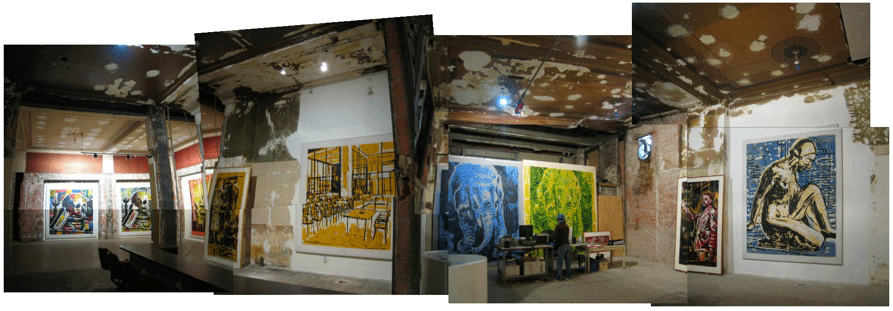
Inmo is a guy and a gallery that has had a first incarnation on Chung King Road in the early days of ChinaTown. Inmo is a strange and funny and strange guy... but I think finally, a good guy who is innovative in ways he is forced to be, a kind of artworld misfit and lucky for it. For example, he has a history of showing architect's work, something completely overlooked by everyone from LACE to LACMA to MOCA to the Getty (institutions here in LA who should be taking on this mantle). If people were freaking out over vandalized museums in Bagdad a couple of years ago in the Iraq invasion... well, there are mountains of historical treasure moldering in the drawers of architecture firms here in this city, retired and otherwise. This, the city of MOCA's Case Study Program. Inmo's next show will showcase Eric Owen Moss.
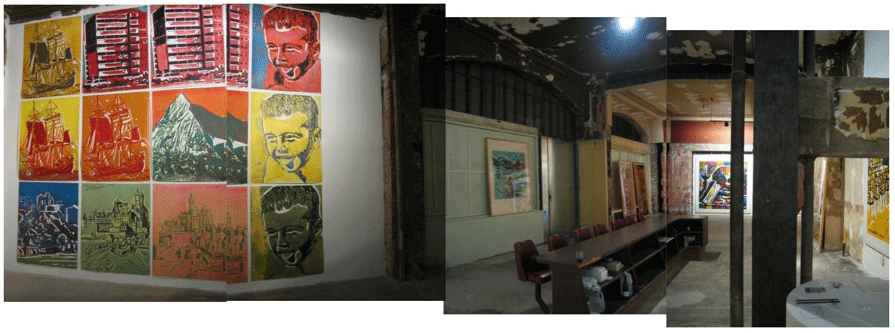
Inmo scored this building probably through some municipal effort to revitalize downtown LA. This place is very much the hard street, with soup kitchens and homeless centers, one must practice a studied cool while tuning up the cat-like wariness to the max. Inmo got what looks to be a former hotel first floor. I don't knwo what it was like when he got it, but it looks like he chainsawed and swept up and then hung up llighting and a sign.

It takes a Roger Herman to hang in this varigated environment. His work easily maches the vivisected vigor of the interior.
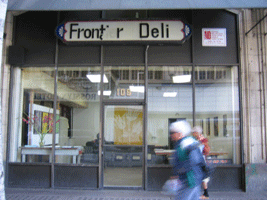
In a previous post, I made a claim of Roger's instrumental influence as a teacher at UCLA. Here is evidence. Across the street, is this storefront. Roger persuaded a famous collector to donate a talented printer and his equipment to the school, housed in this location. Nose to the glass, check it out.
Music at the Rental Gallery
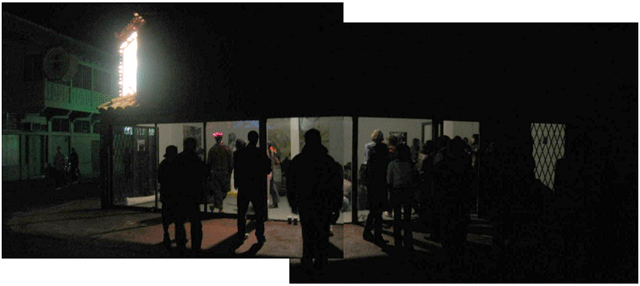
There's no name for this event, it just happens: music evenings at the Rental Gallery. It's that underground, grasssroots, whatever. Matt runs it with an array of spin off activities from t-shirt limited runs, 'zines, flim projects and who know what else he's got up his sleeve.
I'll be blogging more about him later. He's a doer.
This is the second evening and they were drawing quite a crowd, a very interesting bunch of young people. It's humbling/sobering to witness the generational tides, wave after wave. Each group is unique, this one more so.
The music? Voice was singular, full of character without affect. Some were balladiers, others played what I've heard described that night as "Math-Rock". This wave of young artists/musicians are different. I've heard other people remark about the phenomenon of the character of these kids: attentive, patient, ecectic, curious, self confident, independent, innovative, vigilant in keeping the vital center of their work in sight... other, earlier generations would have thrashed the place.
This generation is different.

The great thing is that here in Chinatown, multiple generations are cross pollinating. Easily. Wave after wave and then the sea.
March 19, 2006
THREE PAINTINGS
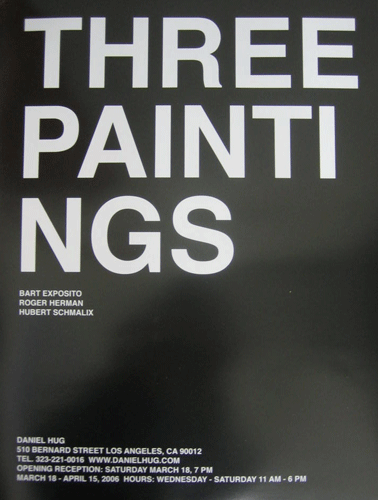
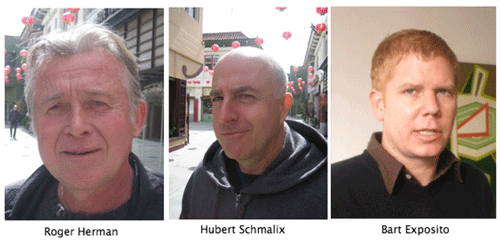
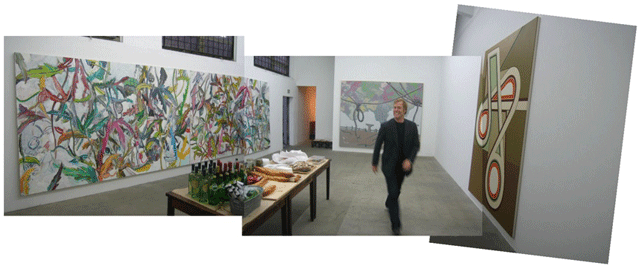
I got to the opening early. This, the first shot where Dan Hug has applied the finishing touches to the table of plenty.

I have described Roger as the pirate of ChinaTown, and I think it fits. He's a rascal, a perpetrator, someone to deal with, an active agent... all of the positve attributes that modernity has tamed the word 'pirate' into. More to the point, Roger is an independant agent as an artist in Los Angeles. He's kind of outside of the system at the same time he is deeply inside the artworld in this city.
He has long been a teacher at UCLA, an active shaper of the program. He has shown at ACE Gallery and has managed to emerge mutually victorious from an collaborative encounter with the monumental Doug Chrismas, a feat formidable in itself. Direct, aggressive, fearless. People have called me the godfather of ChinaTown (shucks), but that label can go to others, Joel Mesler immediately comes to mind, so does Hubert and Roger as well.
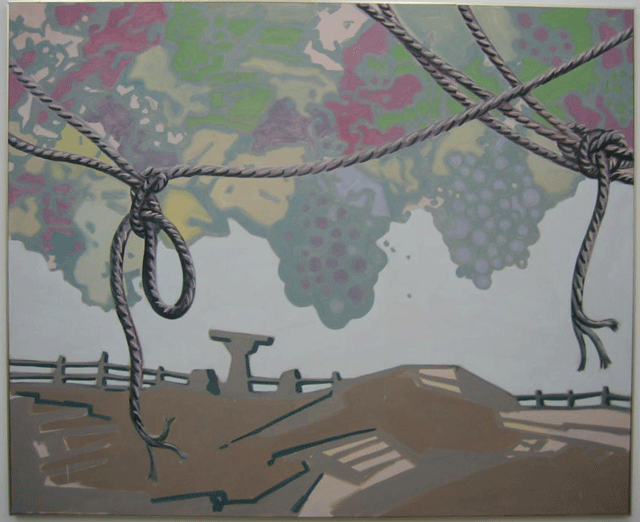
I have heard a lot about Hubert's work over the years, but I had litttle chance to see much of it, so I was glad to see this show. I hear that Hubert is a superstar in Austria. He splits his time between his place there and his place in LA. Looking at his catalogues, I can see the legend of postmodern bondage that I've heard about so much. Later, I came across a local weekly newspaper with the subject of Shibari on the cover... I guess there is an idea in the air. I haven't talked to Hubert about this yet. I hope to soon. Keep posted.

Bart has been gearing up for this triad of a show, the kind of event one's loins naturally girds up with. I mean, when one is about to hang with pirates and godfathers, you've got to get your act together somehow.
And he did. Bart looked good in the room, his fan belt forms spinning and flipping within the frame and between the two other frames in the room.
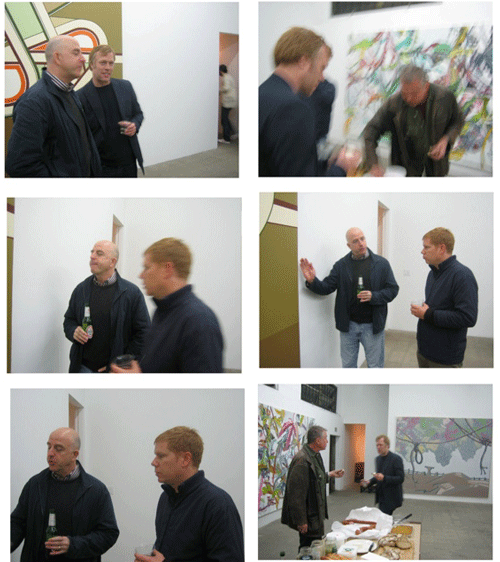
The guys backslap before the crowds come in, the best time to be there.
March 17, 2006
Second Thought
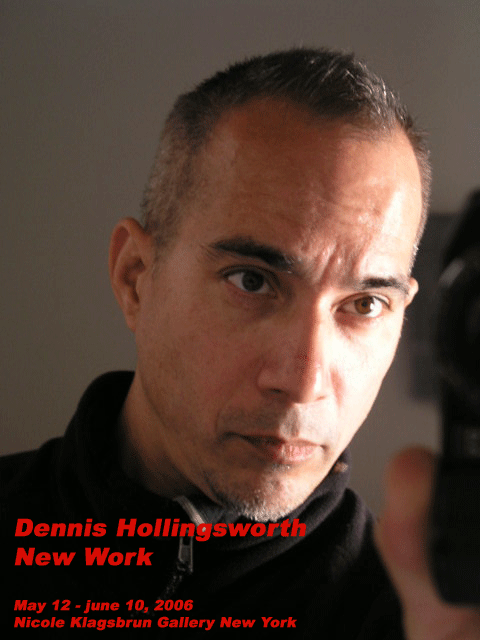
I changed my mind about the title.
Second Thought: Uh, I don'tlike it.First Thought: Really? You don't think it's a good idea?
Second Thought: No. I don't think it's a good idea.
First Thought: Really?
Second Thought: Yea.
First Thought: That's interesting. Do you think that it sounds cheeky?
Second Thought: Yea.
First Thought: ...that it sounds too cute or overly portentious?
Second Thought: Yea. Yea.
First Thought: Could it be considered flip?
Second Thought: Yea.
First Thought: I'll think about that.
My first instinct was not even thinking about titling the show. When pressed, I devised a typical Dennis solution: a non-solution solution of a title about a multitude of titles (the blogpost titles, that is). The bigger argument is that the paintings are not paintings about blogging. The multitude of titles point toward content... and thinking of it, the paintings do too... through themselves, towards content.
Painting first, blogging second.*
Down, boy!Good blog.
Goooooooooood bloggy.
Besides, I'm not big on trumpeting a grand banner of subject for a show. I usually don't paint a group of paintings about... "Mother Earth", or "Fighting the Oppression of Our Tyrant Overloards", or somesuch. As it is, I try to paint in contrary directions from painting to painting... scroll through the past three years of this blog to confirm my claim whydon'tyou?
If the paintings point towards content through themselves, they might be windows by which the facets become cystaline when they become perfect in themselves. Formal mis-takes become obstructions which are polished out to transparancy.
Besides, the blog will always be here. Back up. Bibliography.
I think that it is best that the boundaries of a painting delimits a universe, that when a painting leaves my studio, it will be recontextualized -if I'm lucky- many times and many ways. I've seen attitudes by other artists about controlling the presentation of an exhibition that went waaaaay over the top. They usually end up dominating the presentation so much (announcements, installation, catalogs, whatever) that the gallerists become mere caretakers. The artist sucks up all of the creative oxygen. And what happens after the show? When the collector installs a piece of it in their house? When it is borrowed for a show? After the artist dies (not me right now, not yet... I'm just saying.)?
When a gallery becomes inspired about an install for a show, I consider myself lucky. They all usually ask my opinion, and I give it. But I like that a gallery would own the design of the show, that we could share the expression of the show. What painting should be hung here, there; which painting should be seen first, second, third, across from which painting and in what light. It's all good.
Back to the deadpan: "New Work" or somesuch likewise.
*Although, I have imagined that it would be possible to blog all of life until you puke. The trouble is the puking, or overload, or that curious tendency to devour all of life, only to bring it down to the ultimate fiction of a blogpost.
I remember Dave Hickey writing about this in "Prior Convictions", this taxidermy of life into art, the writer who sees all experience as fodder for fiction. He nailed it.
Mighty Falling

Our art world has gotten so large that it even exceeds the institutional behemoths' (museums ...and universities too) capacty to deal with it. Think about it, think about how big the art world was back in the fifties and early sixties (and most of the seventies and less of the eighties) when one could hit all the openings in town in a single evening and still have time to discuss what you saw at the local pub.
Not any more.
Here in LA, there's too much going on to see all the openings, and even all the shows in the month after the openings. If one does it all, there's a big question as to how much of a life there is in the studio. Only the dinosaur artists here in my city still hit all of the shows (and I see them prowling less so nowadays). Creatures of habit, one can only guess their careers are on cruise control. Good for them, I guess.
Finally, it is becoming clear that the number of artists and artwork is dwarfing the capacity of the institutions to represent what is going on out there in our artworlduniverse. Think about how thundering Godzillas like the Whitney used to be the hot tip as to what was vital at any given time in our art world.
A chain for linking this morning:
1. Chris Jagers.
2. Tyler Green's surgical recommendations and round up.
3. And Green's 2004 WSJ article, even though I don't think a road show will cure the ills that palgue it. A road show might amplify the problem.
One idea sticks for me: that art fairs do what the Whitney promised to do (surveying), but better. And without the annoying wall text. And I guess the fairs don't pin a medal on artists... but then I don't like pomp and circumstance too much anyway. Brass bands and puffy chests put me off.
Maybe the Whitney Biennial should detach itself from the physical building and rove the world's art fairs in an effort to make sense of what can be found therein? I mean, if the mandate is to represent "what is happening now", then what is a better site than the commercial souk that is the phenomenon of the art fair?*
*(The counter argument is the problem of commerce... but isn't everything physical and nonphysical an agent in commerce in our artworld? Maybe commerce is more ontological to art than many of us would like to think? Transactions of private property encompass the physical and conceptual... and even in a utopia free of filthy lucre, there would still be a give and take of ideals and ideas, a commerce by other means after all.)
UPDATE:
Chris Jagers writes in:
Dennis,Beyond the curators acting like artists, I also feel the artists are trying to make work like curators: by assembly. They are creating meaning by merely putting two or more things together without much investment in the things themselves. So meaning is hobbled together from disparate places rather than building it into the work slowly over time.
Chris
(Hi Chris!)
I know what you mean. By "building it into the work", I take it that you mean an imaginative investment. Surely sheer duration, an immersive experience can help one dwell on a... project or artwork or somesuch... and bubble out a captivating... creative act/object/experience or somesuch. (I'm starting to like this "somesuch" word!)
But.
This might be an attribute of our times -you know, Collage City and all that. We assemble computer code, do off shore manufacturing, make lists of instructions, look up FAQ's, watch McGyver, grab off the shelf, cobble together...
And there are so many more people in the world now. That's a lot of cobbling.
Hats are jumping from head to head for some time now. Chris, your note seems to suggest that heads are jumping in those hats too.
March 15, 2006
SNAKEPIT BREAKDOWN

Tomorrow Night, make a date for short plays at the second floor of the Mountain Bar:
PHARMACY presents: SNAKEPIT BREAKDOWN
@ The Mountain
THURSDAY MARCH 16, 8:00
Short Plays by:
Wes Walker
Sharon Yablon
Kevin O'Sullivan
Couch Paintings
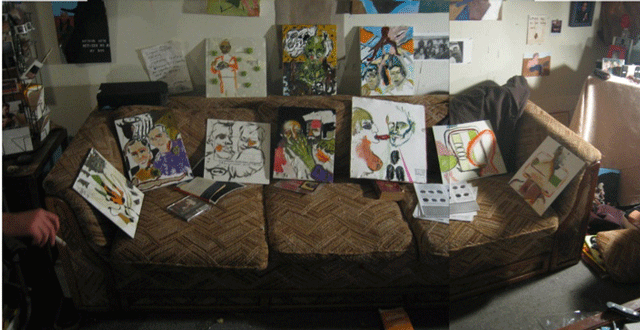
The night before last, the five of us found ourselves belly up to the bar at Hop Louie. A congress of ChinaTown painters in full spectrum: Raffi Kalenderian, Bart Exposito, Joel Mesler, Henry Taylor and yours truely. A beer, two and the idea drops... why don't we spend the evening painting together? Sounds like a party.
So we convened at Henry's studio/pad and mixed it up a little. Henry's a great host. Music, drink, paint. It was natural and everbody worked together like good musicians (or so I imagine since I can only whistle and hand clap). Everyone had a voice, didn't step on each others' moves, there was no grandstanding, no ego, and you can see everyone's hand.
Kismet.
Everyone knew this too.
Jokes and laughing and ideas skit-scat. Everyone got into the work with an easily marshalled rapt attention, all eyes on the ball.
We ended up giving the products of the evening a title: "Couch Paintings", with everyone signing the back of all the paintings. "Why don't we haul out the couches into the hallway and sit the paintings on them and have an opening?" Everybody liked the idea of a grass roots show, down home community stuff, keeping it real, stepping off the suffocating formality of conventional presentation. I liked being open to other approaches, an opportunity to break old patterns and see how the other guys get into their groove.
A toast and a pact. No one dared to spoil the moment by grasping it with the idea of doing it again on another night. If it's natural, it'll happen again.
Here's a few pics without a lot of hablaba:
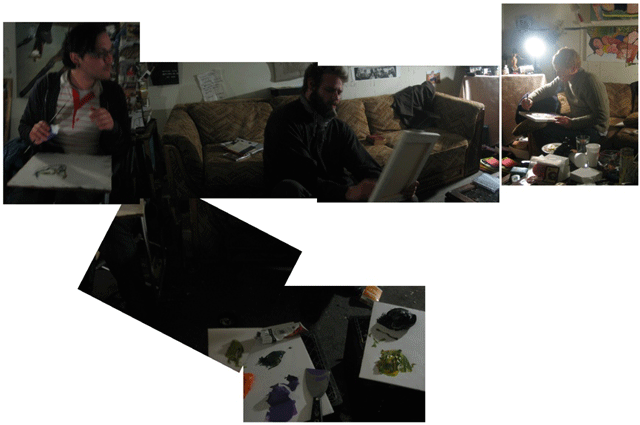

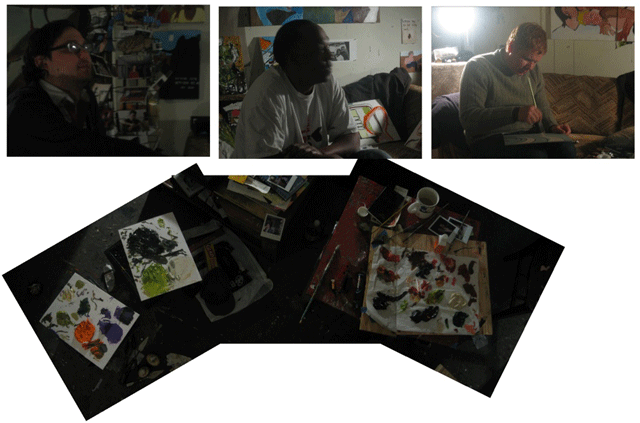
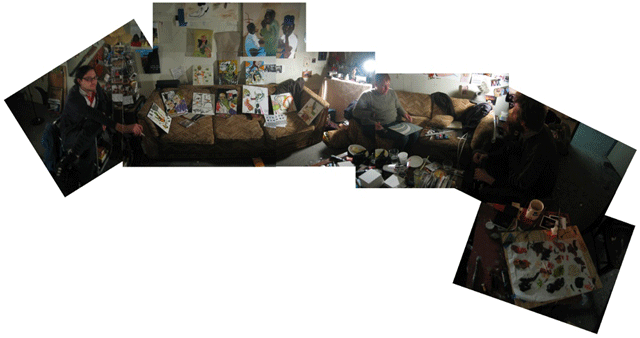

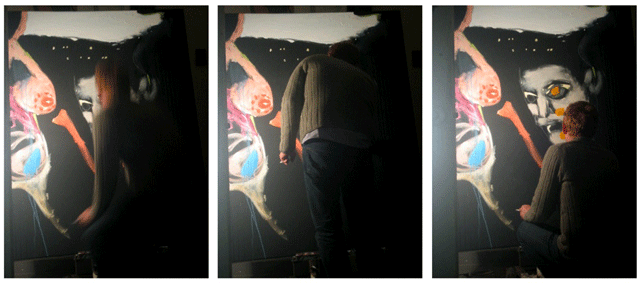
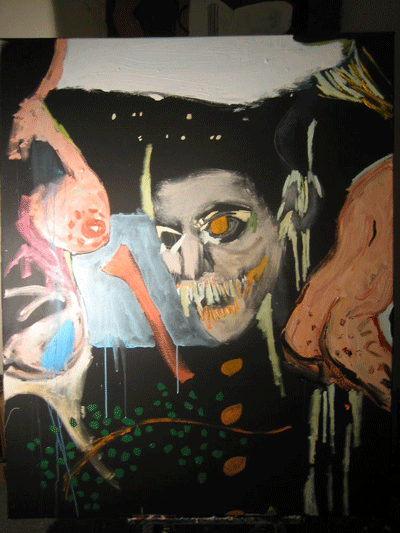
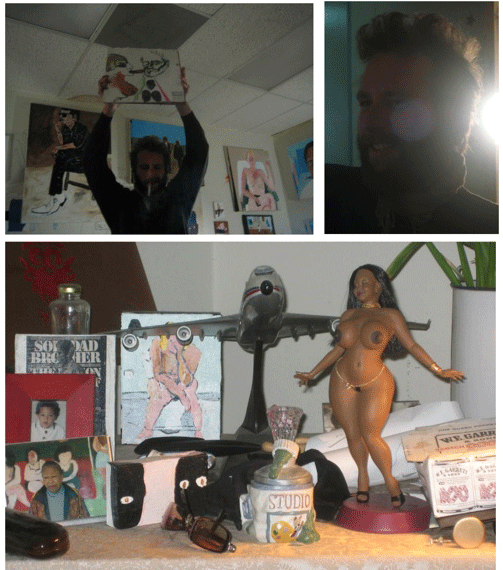
March 14, 2006
PHARMACY PRESENTS
PHARMACY presents: SNAKEPIT BREAKDOWN
@ The Mountain
THURSDAY MARCH 16, 8:00
Short Plays by:
Wesley Walker
Sharon Yablon
Kevin O?Sullivan
"Angelus"
written & directed by Kevin O?Sullivan
with: Andy Hopper & Scott Vance
"The Bonaventure"
written & directed by Sharon Yablon
with: Ryan Cutrona, Kim Debus & Mary Greening
"Spigot"
written & directed by Wesley Walker
with: Chris Kelly & Jacqueline Wright
"El Matador Beach"
written & directed by Sharon Yablon
with: Tom Waldman & Gene Butler
"Snakes and Ladders"
written & directed by Kevin O?Sullivan
with: Gill Gayle & Mickey Swenson
THE MOUNTAIN
473 Gin Ling Way
Los Angeles, CA 90012
(213) 625-7500
events@themountainbar.com
pharmakos.org
Aaron in the Rapids

"Unstuck"
My good friend Aaron Parazette is getting ready for a show at Marlborough Gallery in New York that will open April 19th. He sent me a few images from his studio as he gathers steam for his upcoming show.
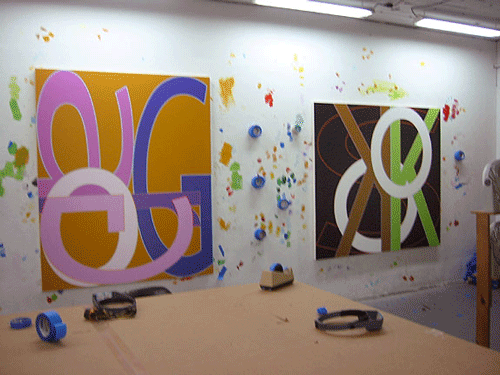
"Agro" and "Stud"
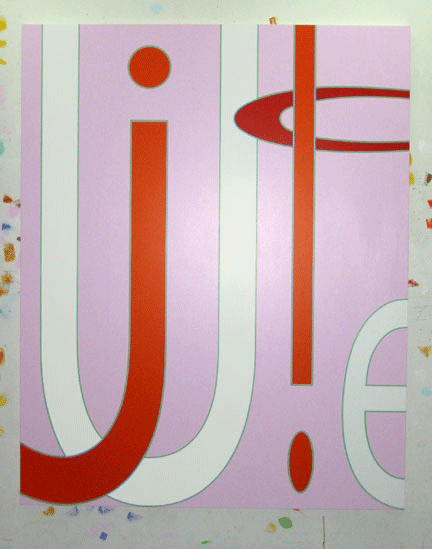
"Juice"
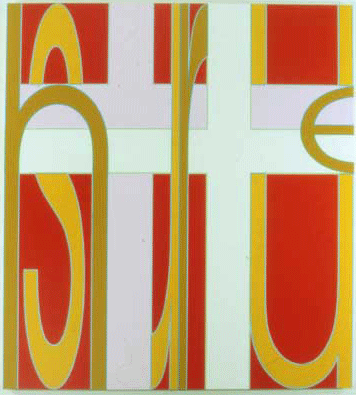
"Thuster".
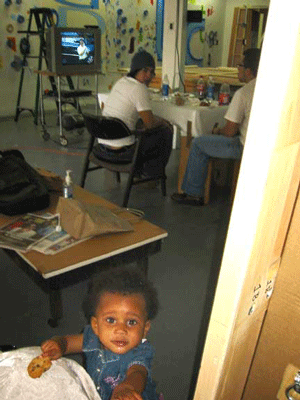
Aaron has been working with studio assistants for the first time since he has had back surgery over the Winter holidays. He has been able to translate a very personal aesthetic from his hands to other hands, a difficult transition for any artist. Here they are, in this last pic with his daughter Joy rounding off the studio action team.
There are few people in the art world with which I enjoy talking to about art as much as I do with Aaron. Deeply considered, researched, nuanced, curious, funny... Aaron is my gold standard for this sort of thing. I called him up to talk about his recent work and our conversation ranged as it usually does. I took notes with an intention to report it here in this blog... but alas! You can catch a butterfly and pin it to a board for analysis and research. But what do you do when you are swinging a net in a swarm of them?
Ok then. I'll shoot a pic of the notes. It's a shadow of the experience, but that's better than constructing a Frankenstein-like fascimilie of the life of that particular conversation.
March 13, 2006
March 12, 2006
The New-Now
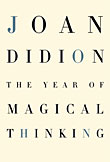
I'm enthusiastic about PodCasting. It's great in the studio, specific radio content on demand. In a future post, I'll list my favorites, but for now I wanted to mention a Bookworm PodCast interviewing Joan Didion. This, an excerpt from KCRW's excerpt from Didion's recent Year of Magical Thinking:
Chapter One1.
Life changes fast.Life changes in the instant.
You sit down to dinner and life as you know it ends.
The question of self-pity.
Those were the first words I wrote after it happened. The computer dating on the Microsoft Word file ("Notes on change.doc") reads "May 20, 2004, 11:11 p.m.," but that would have been a case of my opening the file and reflexively pressing save when I closed it. I had made no changes to that file in May. I had made no changes to that file since I wrote the words, in January 2004, a day or two or three after the fact.
For a long time I wrote nothing else.
Life changes in the instant.
The ordinary instant.
At some point, in the interest of remembering what seemed most striking about what had happened, I considered adding those words, "the ordinary instant." I saw immediately that there would be no need to add the word "ordinary," because there would be no forgetting it: the word never left my mind. It was in fact the ordinary nature of everything preceding the event that prevented me from truly believing it had happened, absorbing it, incorporating it, getting past it. I recognize now that there was nothing unusual in this: confronted with sudden disaster we all focus on how unremarkable the circumstances were in which the unthinkable occurred, the clear blue sky from which the plane fell, the routine errand that ended on the shoulder with the car in flames, the swings where the children were playing as usual when the rattlesnake struck from the ivy. "He was on his way home from work-happy, successful, healthy-and then, gone," I read in the account of a psychiatric nurse whose husband was killed in a highway accident. In 1966 I happened to interview many people who had been living in Honolulu on the morning of December 7, 1941; without exception, these people began their accounts of Pearl Harbor by telling me what an "ordinary Sunday morning" it had been. "It was just an ordinary beautiful September day," people still say when asked to describe the morning in New York when American Airlines 11 and United Airlines 175 got flown into the World Trade towers. Even the report of the 9/11 Commission opened on this insistently premonitory and yet still dumbstruck narrative note: "Tuesday, September 11, 2001, dawned temperate and nearly cloudless in the eastern United States."
"And then-gone." In the midst of life we are in death, Episcopalians say at the graveside.
Michael Silverblatt is an intense interviewer, my gold standard for considering creative work either in a studio visit or in a blogpost. He gets in tight and slows down, bearing in hard on the core of the creative life of his guest. His research is intimate and searing in a most caring and careful way. He must sidle up to the miicrophone superclose, I can imagine what it must be like in the studio with him.
Most formal critiques can have a interrogatory feel to it, an inquisition, an official investigation, a courtroom. Silverblatt is an empath (a favorite word/concept of mine I guess... I sense a repetative tic), a Sensei, a Rabbi, a brother... witness his voice and perhaps you can hear what I do: an intimacy with hat in hand as he gently but forcibly unfolds the thinking of his (artist) guest.
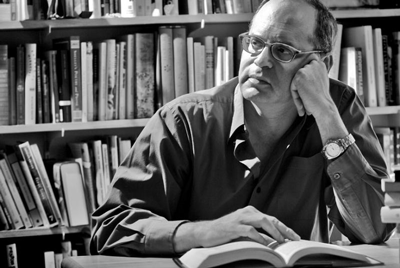
(Source)
UPDATE:
Looking over the Google Search page on Silverblatt, I find Luke Ford's opinion on the worth of my favorite Lit. interviewer.
Searing:
7/28/05I listened to the KCRX show for the first time today to hear Tom Wolfe interviewed. It was awful radio. Michael can take a minute or longer to pose an awkward, pause-ridden question. There's so much dead air. Michael is to talk radio what the Special Olympics are to the Olympics. Listening to Silverblatt, I'm filled with the same awkward compassion I feel for a heavily retarded kid trying to run down a track and repeatedly falling on his face.
Am I an idiot or is this Scott Martelle LA Times article on Silverblatt's show idiotic? There's nothing in it I can hold on to. It's empty words about an empty show. If you can figure out what this article means, please Email Luke.
In particular, could someone please explain this paragraph:
The series is an ambitious effort to engage some of the nation's leading writers ? and a few emerging writers like Mart?nez and David Mitchell, author of "Cloud Atlas" ? in a far-ranging discussion of the nature of self in literature, both as a catalyst for the author and as a motivation for the reader.Then could you explain this: "The programs are vintage Silverblatt, whose low-key but intensely informed approach to interviewing often leads writers to on-air revelations about their own work."
What's low key about Silverblatt bloviating for over a minute trying to form a question? Why does Silverblatt have to lecture these authors about the meaning of their books? Why does The LAT puff up this nonsense?
Silverblatt named the series "Escaping the Cage: Identity, Multiculturalism and Writing," playing off Angelou's autobiography, "I Know Why the Caged Bird Sings," which, in turn, was named for her poem about the human desire to make one's voice heard even when shackled.Anything titled after anything Maya Angelou has written is likely to be nonsense. There are some voices that should be shackled -- ok, that's too strong, and I don't really believe it, but my shackling tendency just overcame my better self. Why must I get angry before I can blog?
The funny thing is, I like both Luke Ford and Michael Silverblatt. Luke's got a point here. The Maya Angelou interview, I didn't like either (because I didn't like Angelou or Silverblatt's fawning approach, too uncritical). But Silverblatt would have made sure he had spelled the name of the radio station correctly. After inspecting the links, you might conclude this is a Left/Right pissing contest, but a closer inspection of Luke's oeuvre will reveal that he's quite a rascal in the lofty, formal and ultimately (up)tight house of the Right. "Nearer My G-d To Thee" indeed. Personally, I don't believe in Right versus Left... like Painting, I believe in Abstraction plus Representation. That's why I like his work too.
I found Luke Ford's site through Cathy Siepp's blog (a very good writer here who lives in SilverLake), both I highly recommend.
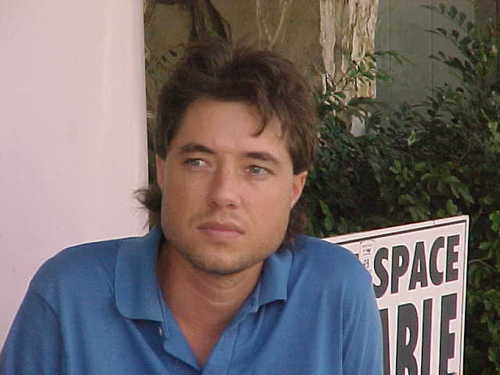
As a matter of fact, I'll put them into the Soup of Links forthwith.
One last thought on the LukeFord/MichaelSilverblatt issue: who would you rather be: the rascal in the pews or the saint in the whorehouse?
March 11, 2006
Raffi Kalenderian
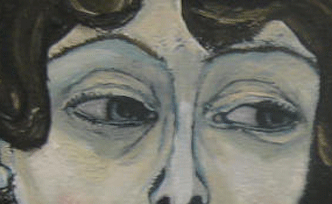
I met Raffi several months before I saw his work. A mutual friend introduced us and he visited my studio, a good visit. We spoke of Greco's eyes. Watery jellied oysters for G-d. I couldn't find an image of them and I worried a little that my imagination was freelancing too much. I don't remember how we came to this, but later as I got to see his new work at Black Dragon Society, I realized how resonant Greco was with Raffi's paintings (and not lliterally just the eyes, but perhaps the eyes as portals...).
Raffi emailed the image:
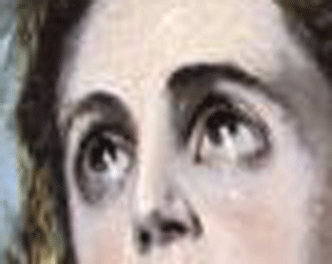
jellyfish-like eyes we were talking about oh so long
ago.
I replied:
I'm delighted that we spoke of Greco when I hadn't seen your work before. Your stuff is very resonant with the old Cretan/Spaniard. Have you read much of his letters or of the world around him? I haven't myself but now i am curious about his biography and what he was like psychologically. I wonder if he was like E.A. Poe, a Goth thing? I google for bio and find little. He apprenticed under Titian. Or this: "The strangeness of his art has inspired various theories, for example that he was mad or suffered from astigmatism, but his rapturous paintings make complete sense as an expression of the religious fervour of his adopted country. " Or maybe it's about the dynamics of Mannerism, inherently. Still looking.
Raffi responded:
i too am glad we spoke of el greco. i feel like his
work has so much to offer, whether it's his
immpossibly gelatanous eyeballs, incredibly dynamic
composition, or just his keen sense of the phenomenon.
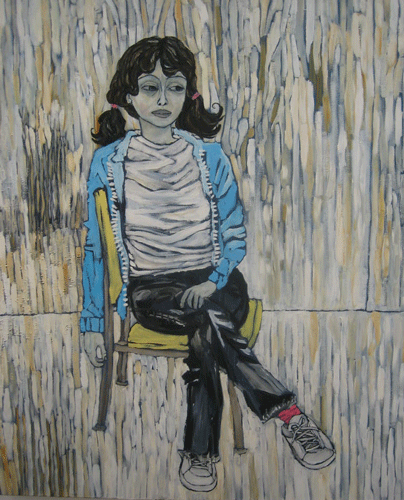
i have a book of his, that goes into some
biographical information. the one thing that stands
out is that he sounded like quite a diva. he would
spend lavishly, constantly in debt, and argue with
patrons about the price of his work. often there
would be an arbitrator to come in and decide how many
"ducars" (or something like that, i am forgetting the
name of currency) a painting would officially cost.
often the arbitrator would side with el greco, which
pissed off the clergymen or royalty or whoever had to
pay top dollar.
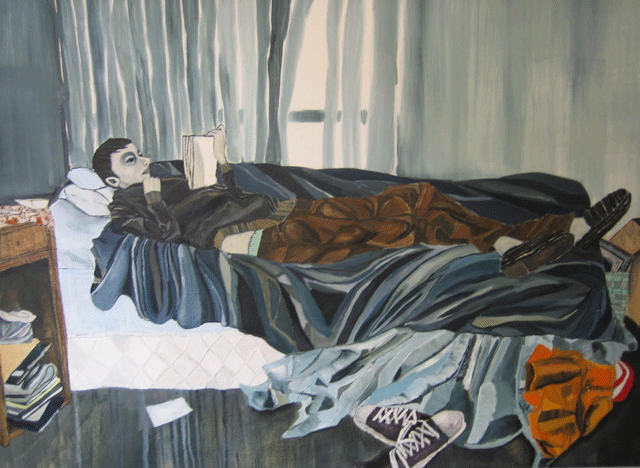
i am planning on painting a tryptic
from my balcony here in highland park. the hills
here, and often the sky, look very much like the
landscape of toledo he painted, and i thought i could
use that menacing cloud scheme as a backdrop for three
portraits of people on patio chairs.
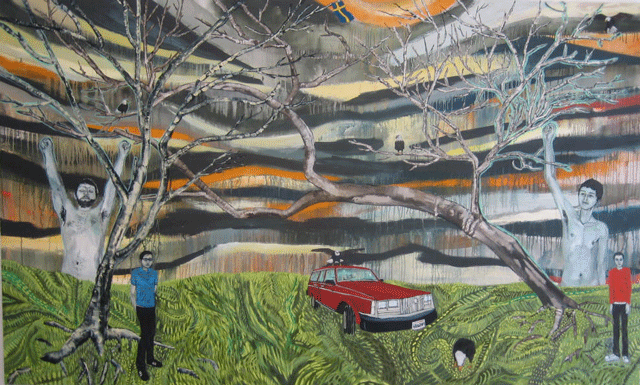
Details here, and here.
He continued:
please feel free to post pics on your blog. it would
be an honor, really. there is something about your
analysis of my paintings that stood out:
The pictorial world automatically snaps to these
coordinates and plots a world... versus a painting
constructed bit for bit and eventually alluding to the
possibility of a world out there.
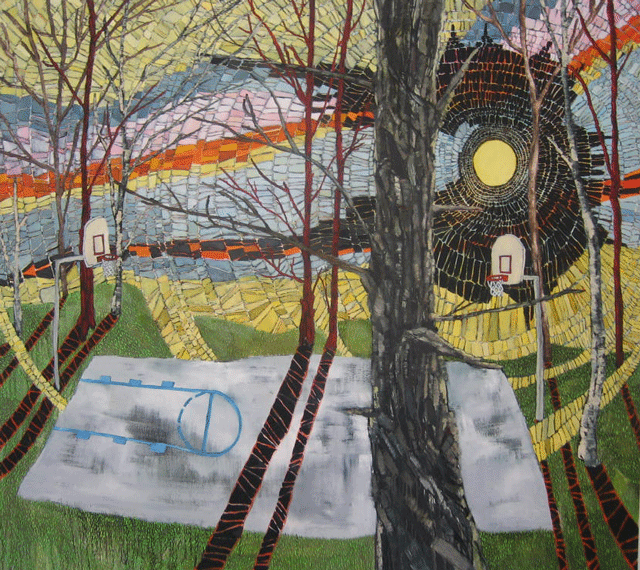
i think i am projecting, since i think about this
stuff alot, but the first situation describing a
pictoral world which is dictated by a series of
specific plots seems to be the more didactic,
authoritarian approach. whereas the second situation
lends itself more to investigation and participation.
i feel like the painting of the basketball court in
the forrest is a clear cut version of the first
situation, and the portrait of my brother reading on
the bed is more in the second catagory. i think
making both strains of work is important, but i think
i am trying to lean towards the second approach.
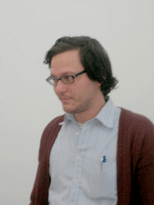
Reality is an Activity of the Most August Imagination

Andrew Hahn, the curator (and painter, his solo is scheduled for May at Sister in ChinaTown), told me of his delight of his choice of the cover of the Camus "Stranger". He was running on intuition (not his words). Later, he realised how appropriate it was that mimes graced the announcement for the show. Mimes are using fragments to represent a whole, to conjure a whole in our minds. It is a congress of imagination, theirs for evoking a scene and ours for completing it.
I can't recount our conversation exactly ....shaking my fist in the mirror: why don't I remember to pack the tape recorder? He talked about CalArts and how Continental Theory was an overlay on art that -as it spent itself out- made him realise that his original love for fiction was an overlay too, and a better one than the ballroom-dance-by-the-numbers that 80's legacy art theory was for illuminating art. Someday, I'm going to record, interview and podcast with a vengance, just wait.
Back to the show...
It was something about apprehension that puts it all together for him. Andrew is seizing a fragment here, another there and trusting the dotted lines of imagination -ours and his- to put the picture together, a picture he is feeling out, one he does not know in advance. He's exploring, antennas fully deployed.
It is important that ours are delpoyed too.
I reprise from the announcement post, a shorter selection from Wikipedia on Wallace Stevens:Imagination and Reality
Stevens is very much a poet of ideas. ?The poem must resist the intelligence / Almost successfully,? he wrote. His main ideas revolve around the interplay between imagination and reality and the relation between consciousness and the world. In Stevens, "imagination" is not equivalent to consciousness, or "reality" to the world as it exists outside our minds. Reality is the product of the imagination as it shapes the world. Because it is constantly changing as we attempt to find imaginatively satisfying ways to perceive the world, reality is an activity, not a static object. We approach reality with a piecemeal understanding, putting together parts of the world in an attempt to make it seem coherent. To make sense of the world is to construct a worldview through an active exercise of the imagination. This is no dry philosophical activity, but a passionate engagement in finding order and meaning.
The Didion in my colophon is proof that I am a fellow seeker of this sort of thing.
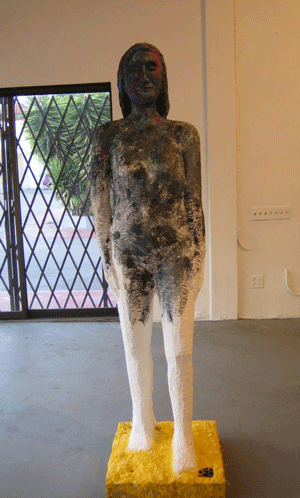
Ruby Neri "Standing girl" 2006, plaster & acrylic paint.
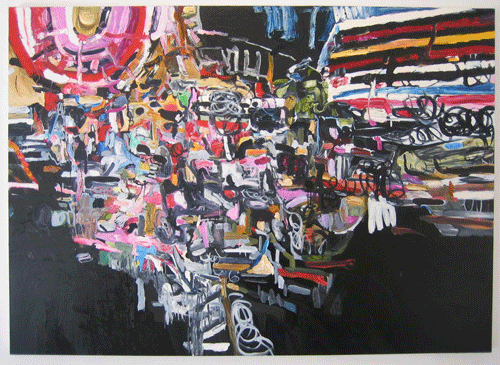
Pam Jorden "Untitled" 2005, oil on canvas.
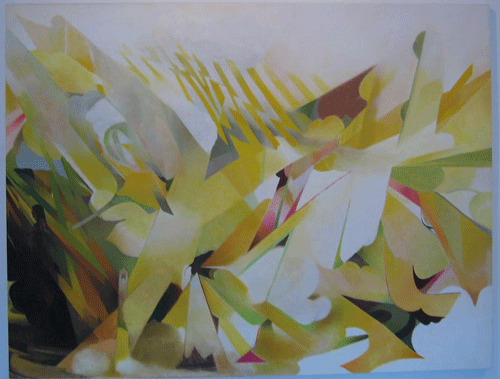
Tyler Vlahovitch "FunPark" 2003, oil on canvas.
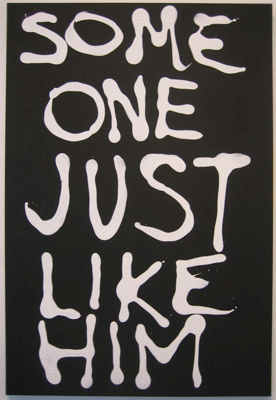
Mitchell Syrop "Someone Just Like Him" 2005, paint on board.
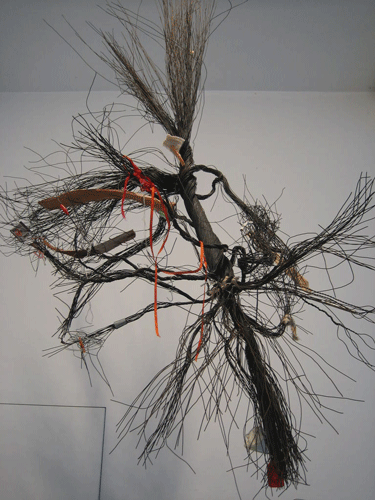
David Hughes "Untitled" 2005, various elements.
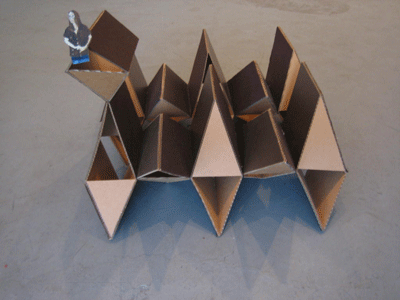
Alice K?tnitz "Untitled" 2002, cardboard, felt, vinyl.
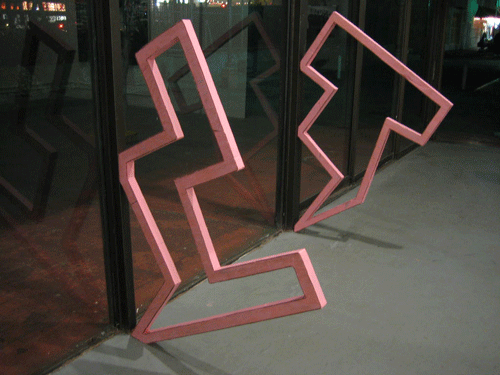
Patrick Nickel "Poppyseed + Clover" 2004, plywood, cardboard.
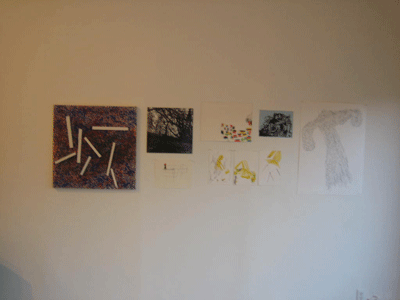
Wall of drawings, from left:
(Pan Left)
Ruby Neri "Inside the Blue" 2005, acrylic + wood on canvas.
Mitchell Syrop "Untitled" 2006, photo on board.
Alice K?nitz "Untitled" 2005, pencil + thing on paper.
Pam jorden "Untitled" 2005, paint + adhesive on paper.
(Pan Center)
David hughes "Untitled" 2006, ink on paper.
Tyler Vlahovich "Untitled" 2000, ink on paper.
Patrick Nickel "No Title" 1998, pencil on paper.
(Pan Right)
UPDATE:
Andrew sent in this postscript:when i said that that title ('reality...') was a personal philosophy for stevens, and that the activity, for him, was writing, i was thinking about this quote: 'it is a world of words to the end of it / in which nothing solid is its solid self.' i can't remember what poem that's from, but in 'reality...', he writes: 'there was an insolid billowing of the solid', which i think is how art should be experienced, first tangibly, and then within one's own mind. -hahn
March 10, 2006
Jaime's Place Remembered
Gerry has another pic from last summer when we bumped into Jaime and shot pics of his studio.
Henry's Opening

Henry Taylor has a show at Sister Gallery, let's check it out:
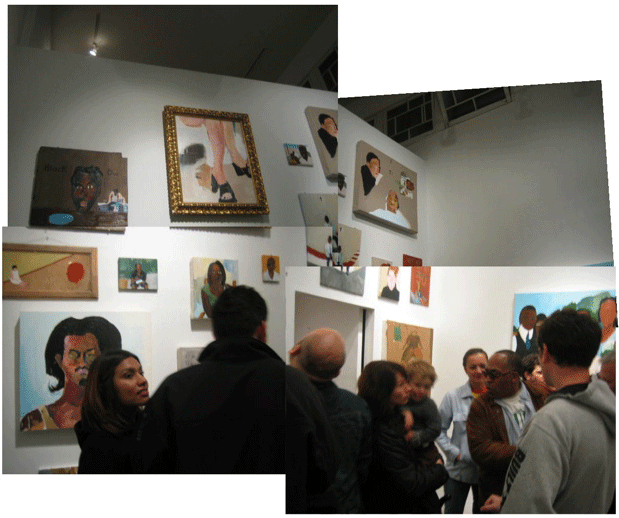
It was a crazy night. Henry was on fire.
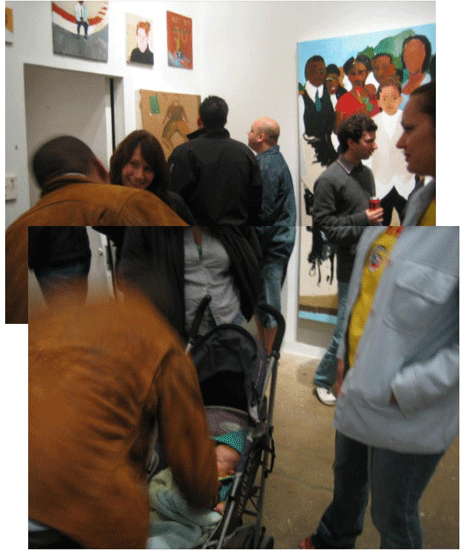
Henry's a people person, he could be a politician. Easily. I've watched him. He has taught me by example: he focuses on what is good about a person and lets them know that he sees it. Loudly. Repeaedly. Graciously.
But all this sounds too breezy.
How about this:
One
Respect.
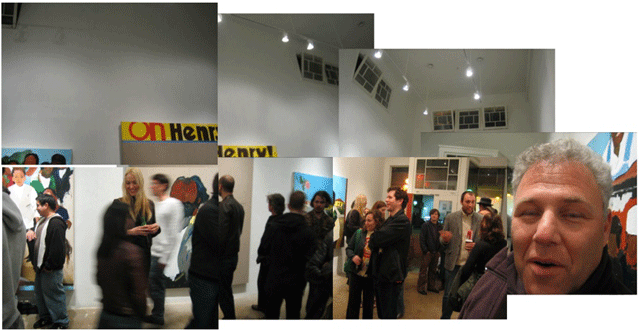
He had a friend of his along with us and he introduced me by describing Tossa: "Their place in Spain is crazy great. You know what I mean? I mean, it's almost boojie, but it's cool tho. You know what I mean?" I thought, hmmm. Bourgeois versus bohemian. Have these guys chosen sides? Do they really believe in this 19th century dichotomy? Then I asked Henry about his history. I wanted to hear it from him and not second hand.
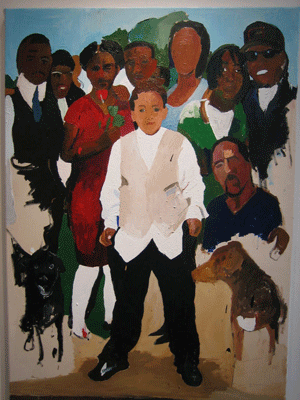
He told me about growing up in Central California. I went to undergrad school in San Luis Obispo, so I have a feel for what he was describing. Ventura, Santa Barbara, Santa Cruz, MoorPark. Central California. He painted as long as he could remember and in time, fortune smiled upon him and he gained the nurturing support of a patron who was smart enough to urge him to go to art school.
CalArts.
"What was it like for you there? I've heard it was an egghead place. How did you deal with the verbage? " He said he didn't. He said it was pretty intimdating for him at the time. He listened more than he talked. Moreover, he spoke with his painting and installations. They must have seen and respected the street in him. Henry's been to the places others timidly dare to dream about.

(A semi-not-safe-for-work glimpse of heaven here)
Later, I heard one his fellow students describe a church that he built behind the school. They would bar-b-que and party there. CalArts has a legend for debauchery ...real or not... a topic only described furtively whenever I had occassionaly found a witness to provide testimony.
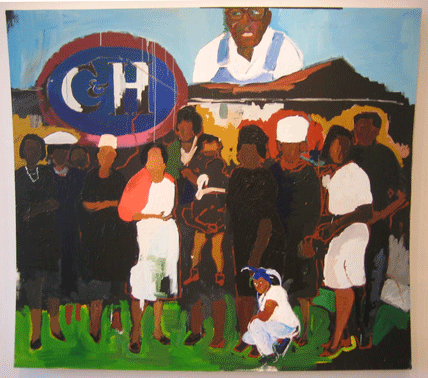
(I think this might be a self portrait of Henry here. He wears the jester's cap but his eyes are wary. The street is like that. And he has no mouth, no voice. High theory art dialog has a tendency to wipe off a mouth now and then. Henry doesn't need it, especially in these times when world historical-cultural tectonic plates are shifting and crushing the coordinates the social structures worldwide. Better to see more than one speaks.)
The real nugget came when he told me of his work in a mental institution.
Ten years, he was an hospital orderly. I wish I could recount the stories he told me of those days, but 'm afraid that I would maul them. I can write of my response, though. I remember visualizing "One Flew over the Cukoo's Nest". Strange, that my first thought was of a movie. More vividly, I remembered my dad, who succumbed to clinical depression in his last days. I know the smells, the colors, the sounds, the texture of the air, the sadness, the fear, the way memories of better days flood into the wretched, horrific new-now... and the suffocating pall of the bitter juxtaposition of it all... feelings that one would only want muffled in the distance of time.
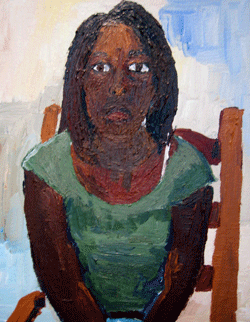
Henry told me of the people. He loved the people. As he described some of them, his eyes wold tear up as we drove across town. One woman would get in his face and call him a nigger. A racist or simply out of her mind... one or the other or both? Tourette's? I said something like "...that must have been hard..." but no, Henry said that she was a good person. There was affection in his voice. I could tell that Henry saw past the abberations to the soul trapped inside the madness. The tears were for the prisoners.
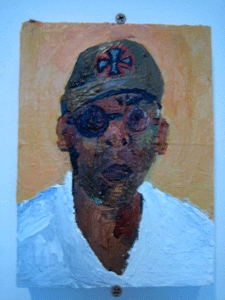
Empathy.
Henry is an empath.
A good man.
Later, I heard stories from mutual friends about the former inmates of the menatl hospital who would look Henry up after they were released. henry would take them out and buy them gifts. Clothes. Jackets. Things to help them readjust to the world. Henry has seen the hard edge. He's been there.
Henry is an empath. A good man.
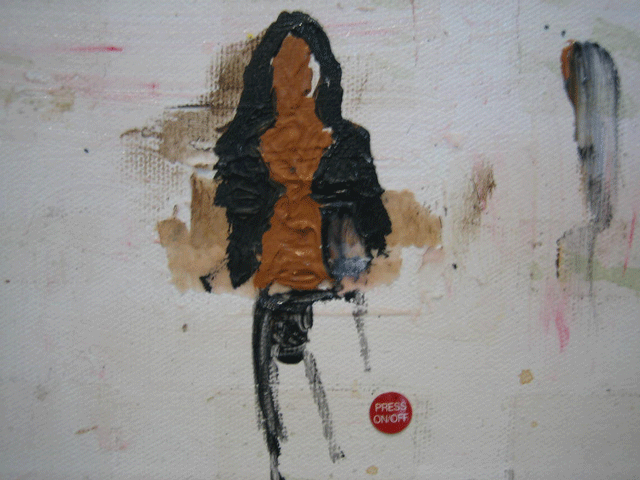
(This is a little one. It could fit in the palm of our hand.)
Henry is an empath. A good man.
One last story.
The other night, a constellation of ChinaTown regulars happened to find ourselves belly up to the bar. The conversation was hot and skat and everyone was enjoying each other's company. The night stretched into the wee-I mean-wee hours where everyone who was left knew they had just burned the next day down - and now that all that remains is the task of recovering from the liberties taken with such relish that spent evening. Bleary. Inhibitions demolished, restrained only from similarly destroyed motor control.
Henry got into my face. I thought, what's this? A confrontation? A vainglorious mano-a-mano peacock strut? Henry's nose was less than an inch from mine, so much so that his eyes went all Picasso, Cubist period. Blinking black ovals slid one atop the other and still Henry got closer that our noses bumped and his eyes merged into one big glistening blinking Cyclopian orb. Was he going to kiss me? Was I going to learn another, hidden side of Mr. Taylor? Or was he going to riff in another great stream of consciousness free verse? I was hoping for that.
I stood my ground, game for what ever would come (within limits). My eye must have looked the same to him, Cyclop to Cyclop. he began to tell me of his cousin. A woman he loves, a childhood friend. he told me of the connections in the family and how everyone loved her so. He spoke of how much of a good woman she was. Then he spoke of the cancer that took her away in her youth. His gigantic eye was glistening, widening. He missed her so much. He missed her so much. The eye was wet, tears streamed. "You've got to remember these people, Dennis!" Tears wet everything, his face a river delta. "You've got to pray for these people, Dennis!" I held him but I didn't dare break the Cyclopian orb. "You've got to pray for them! You have to remember them!" I thought of the people I have lost in the past decade. I thought of the people he must have helped in the mental hospital. "You're right Henry." I envied his capacity to release like that, but two of us going down that road is too much. I checked myself with a trace of shame or regret, I don't know which. One of us had to be the emotional designated driver. I tried to comfort him but I know that I came up short. I made a silent vow to find a way to pray someday, to do it right. Henry slumped back and went into another part of the room in a heap.
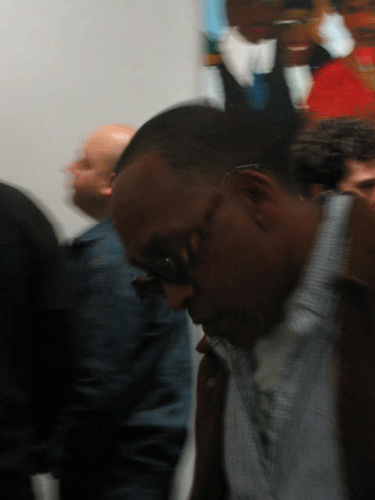
Ahora
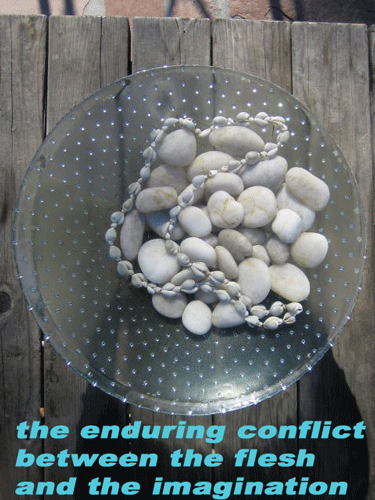
Context:
For modern artists and writers, the fascination of Spain has had everything to do with the wrenching conflict between, on the one side, the country's fearsome Catholicism and calcified aristocratic traditions, and, on the other side, Western Europe's seemingly ineluctable embrace of progress. The authoritarianism of Spanish experience pushed the country's greatest artists and writers to dramatize a yearning for modernity. Some of these dramatizations were conscious acts, such as Goya's Caprichos; but sometimes what we now experience as an unruly individualism may not have been the artist's design, as in the expressionist disquietude of El Greco's View of Toledo and the caught-at-an-angle realism of some of Vel?zquez's portraits. And yet Ravel was not wrong, in his Pavane Pour une Infante D?funte, to believe that Vel?zquez understood the private longings of the princesses whom he painted. And nobody can doubt that Daumier, one of a long line of artists who took an interest in Don Quixote, was justified in seeing the contrasting profiles of Sancho Panza and the Don as an image of the enduring conflict between the flesh and the imagination. By the time this tormented country became the first battleground in Europe's twentiethcentury conflict between democratic individualism and fascist reaction, artists and writers could be forgiven for imagining that Spain's greatest creators had been warning for centuries of what was to come. Picasso, when he painted Guernica, capitalized on those echoes, re-framing the calamitous aerial bombardment of a Basque town in visual terms that hark back to Goya.(Source)
March 9, 2006
Hello World
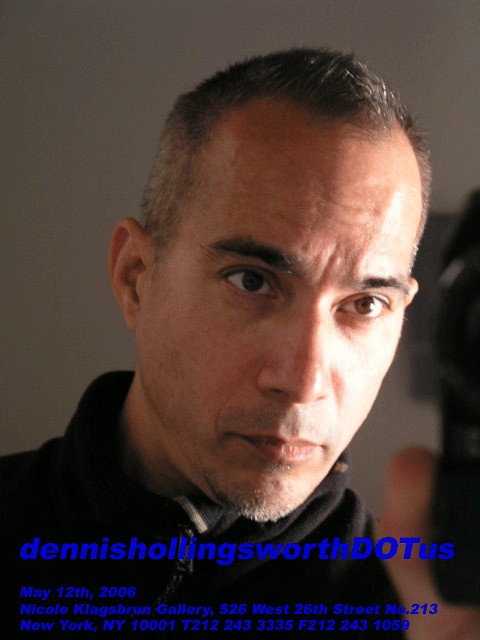
What's this?
My gallery asked me if I wanted to title the show that's coming up at my gallery in New York, Nicole Klagsbrun. I was surprised that I was taken by surprise.
An acquaintence once said to me -real slow for emphasis: "It's show biz-ness, Dennis.
I disagree. Art is bigger than that.
(But I'm a stubborn jackass sometimes, so some people have said. Even so...)
Designing art for a show, much less paintings, seems crazy to me. First, there is the problem of how design distracts from the (albeit dangerous) self centering plunge required to plumb the depths (sometimes and even though such as they are). Unless the show is bought or otherwise taken and protected by a collector/custodian, it will be dimembered and dispersed into the world. It's so ephemeral. A few weeks and it's over, cut to pieces. Paintings-meant-as-installation doesn't do it for me.
Paintings are singular and in relation to the entirety of the life that made them and the world that made that life.
A show for me a slice of the studio, an interval of experience where a lifetime's arc of curiosity is hologrammed into each painting. One follows the next in a trace of the movement of a mind in the world. Each painting is a piton hammered into a mountain, each one pointing emphatically towards an immense topology called inspiration.
***
Or something like that.
Soooooooo.
The image above is an ad.
I named the show after this blog.
![]()
It seemed like the right thing to do.
March 8, 2006
Worth Repeating

The previous post doesn't convey reality very well.
Here's another try.
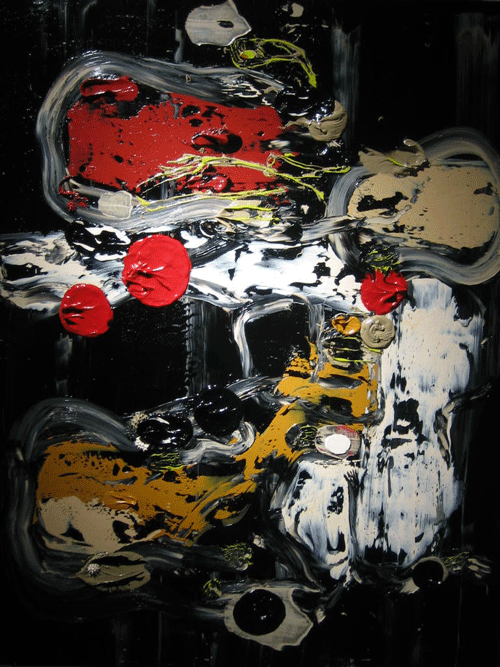
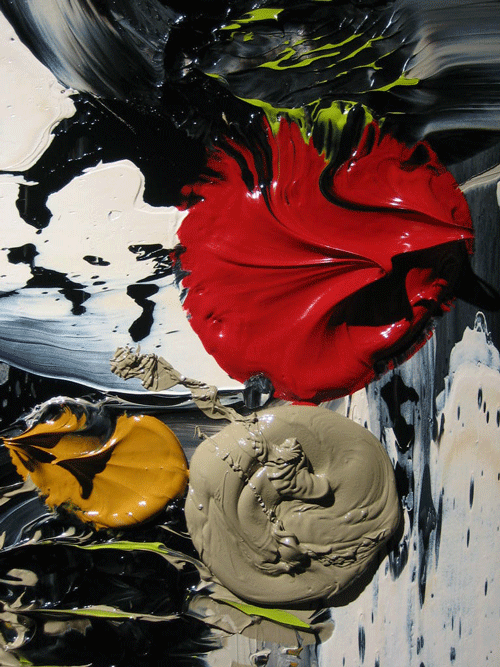
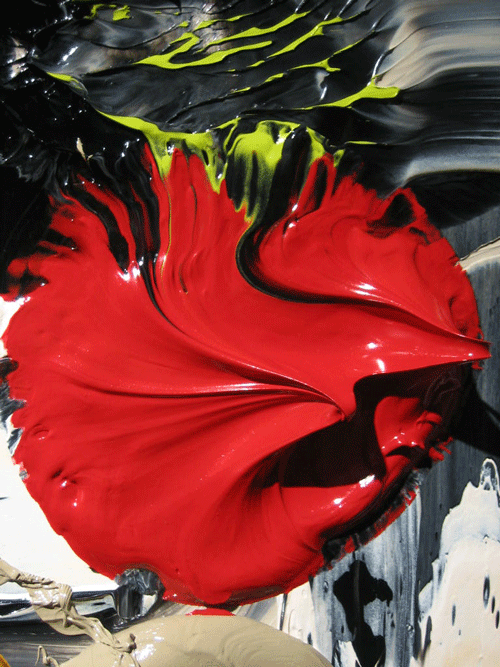
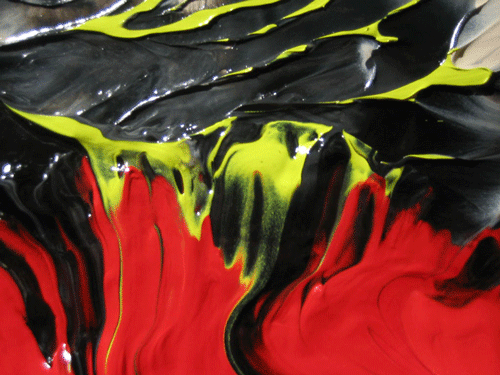
Hold all this at once in your head, and this is kind of what it looks like.
Night and Day
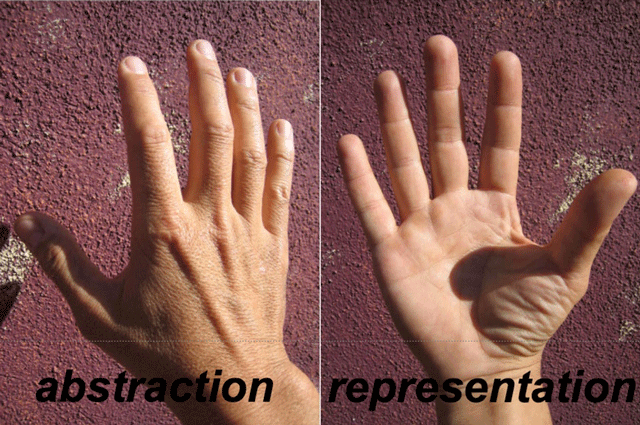
It's worth repeating.

Back of the hand:
ColdPalm of the hand:
Rough
Tough
Hard
"Back of the Hand"
"B--tch Slap"
Knuckles
Nails
"Sweep of the Hand"
Nurture
Comfort
Protection
Care
Loving
Generous
Soothing
Why would painting be one to the exclusion of the other?
***
The West has a blind spot. We can't see how things go together because we are so good at singling out an individual from it's context. It's what we do.
But blind spots aren't so bad when you know you have one.
(Cole Porter)
Like the beat beat beat of the tom-tom
When the jungle shadows fall
Like the tick tick tock of the stately clock
As it stands against the wall
Like the drip drip drip of the raindrops
When the summer shower is through
So a voice within me keeps repeating you, you, youNight and day, you are the one
Only you beneath the moon or under the sun
Whether near to me, or far
It?s no matter darling where you are
I think of youDay and night, night and day, why is it so
That this longing for you follows wherever I go
In the roaring traffic?s boom
In the silence of my lonely room
I think of youDay and night, night and day
Under the hide of me
There?s an oh such a hungry yearning burning inside of me
And this torment won?t be through
Until you let me spend my life making love to youDay and night, night and day
March 6, 2006
Ahora/Admin/MailCall/
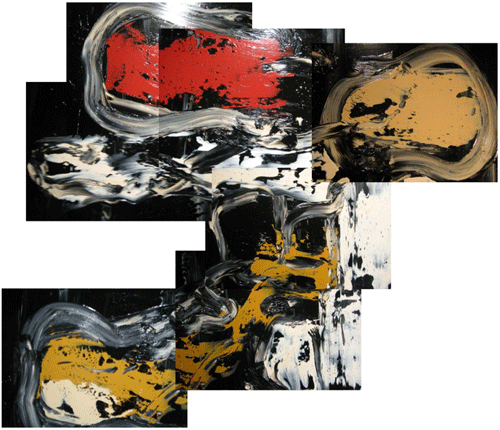
(This, a shot of a painting in progress -the first touches in the first four hours after the most recent of three previous scrape offs.)
Once upon a time, an art world guy asked: "Can I watch?".
"Uh, I don't think so." was my response. That would mess my head up, I'd end up performing, not thinking of the work at hand. I woldn't be able to get deep, I'd skip on the surface. Too close. I keep no company in the bathroom nor in the studio. Nuh uh. No way. Not gonna happen.
The reason why? Shyness, of course. Though I struggle against it. But there's more to it than subjective catatonia.
Painting for me is a alternating series of small achievements and failures and achievements in tumbling succession. And sometimes the most marvelous paintings occur after proceeding through the most wretched passages. Great beginnings, stumbling surprises, car wrecks turning into train wrecks, fast gambits and slivers of hope, smothered desperation, and then if I am ...lucky... grace. I cannot anticipate when or how this will occur and certainly, after having experienced wonderful paintings snatched from the jaws of defeat -as it were- I tend to lend myself to sustained bouts of doubts... heavy, heart wrenching, horrible, sickening, nauseating doubts. Why? Because I believe that this is a tempering process: that by alternately superheating and plunging into cold water, the stress might forge a better painting. It's what I think of as a wisdom perculiar to painting, won through hard experieince.
Now, imagine being in this terrible-but-still-good place...
And someone else is in the room,
Watching what you are doing.
Having thoughts.
Looking at you.
Like they are going to do anyway in the exhibition, but a thousand time worse.
And then I started to blog. (Slap the knee with the hat. Guffaw.)
Is it the same difference or if not, then what's the difference?
Well, one crucial difference is that while I consider this blog a bibliography or appendix to the paintings, and even though I have thought of it also as a virtual studio visit. such a virtual visit is controlled ...like an actual studio visit. In this situation, people arrange an appointment and I try to be productive around this monument of distraction in my day (albeit important as it is). I'd clean up, in other words. As in a mirror, while one can dial up this site and drop in, what you see is tidied up a bit. Still controlled. ?Claro que si? ?Como no?
I think of the Picasso film "The Mystery of Picasso", that famous Claude Renior film of the artist at work.. I Googled and found a site with an interesting description:
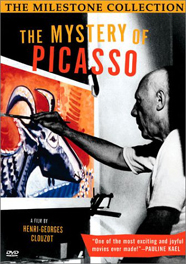
For a while, it doesn't seem very promising, as the early images are barely more than impressionistic cartoon half-sketches. One of the first ones proceeds past what seems an apppropriately finished state, to be more or less ruined-looking. Interestingly, instead of being able to conclude that 'with every work of art there's a point of perfection' that one must attain without going beyond, we here realize that for every finished painting we see, the artist has has to deal with a living, growing entity, and only he could decide when it was finished.
Further down, dark loamy earth:
...That's when we realize that because a painting-in-progress 'changes' with time, the 'mystery' is that Picasso is almost telling a story with his painting. It has anticipation ('looks like he's almost finished this one') and suspense ('what's he doing now?'). When the picture is done, we're left with a complex awareness of earlier images and abandoned directions. The visible work is just the top layer painted over the now-buried earlier versions.
One realizes that painters must look at their finished canvasses and think not of what's there, but of the earlier versions underneath that only they can remember, like the invisible alternate futures of a Luis Borges time-travel story. The creation of each picture is an animated film, an adventure where the director (Picasso) launches himself into regions unknown, and takes us with him.
There you go.
Therefore this blog.
***
And now, the mail:
(BLOGPOST IN PROGRESS)
(Somehow, a day intervened in the posting of this enty. Whoops.)
Moving along... from the most recent correspondence:
Steve LaRose dropped a line about the beginning of this blogpost (I paraphrase):I know that you are not done posting for tonight but I just wanted say, "See, see, that's why musicians have it made! Imagine making mistakes, taking chances, reaching highs, plowing through the lows, getting in a groove, getting in a rut! Imagine doing all that, while someone else is watching! Not only watching, but participating! Responding! The painter's studio is so lame compared to being in a band. The shitty thing is, I have a tin ear and no soul. I can hardly wait for streaming video blogs."
Oh, you've got a soul Steve. (I thought you were in a band once upon a time, correct?)
I know that one day, this transparency thing will go global. That is, our every act will be open for inspection and we may have to invent reasonable shadow places, virtual private domains to chill out from the white hot heat of public scrutiny. The day when we can go to the local Apple store and buy the latest version of an Apple G-50, the guys at the genius bar will unscrew a box from which wisps of nanobots will fly up your nose and subsequently install themselves onto your optic nerves and cerebral cortex or somesuch organ... and wala! Online 24/7 with a wink and a nod.
Until that fine day....
In that email exchange, Steve was concerned about the public/private confusion in the act of sending me emails. I shall forthwith add a tag to the notice in the left margin requesting people tag their correspondance as a blog comment so i don't inadvertantly post private correspondence.
Done and done.
***
Working backwards into my mail archive, My young friend Alberto Barcia Fernandez asked a question:hi dennis,Thanks Alberto, and no worries about the English. You're doing great. I wish I could speak Castellano as well as you speak and write English.
I?ve seen your last painting, and I don?t know why that you say in the blog that you don?t like it at all. I'm not sure sometimes... it?s hard for me to understand the context without get confused, I have to improve my english.
I just want to tell you that in my point of view it's a very good painting and a very good allusion to Goya?s Saturn.
Realmente me gusta la incorporacion del figurativismo en tu obra, yo he estado pensando como hacerlo en mis pinturas, sin encontrar la manera de hacerlo, es por eso que al verlo en esta pintura tuya me he quedado impresionado.
Alberto thinks that I am "incorporating figuration into my work". This reminds me of a question that Chirs Jagers sent in recently:
Dennis,I have loved your recent posts about how your paintings look different through the lens, particularly the one that broke out of the rectangle (perhaps an idea there). I almost feel like the art that gets promoted nowadays is specifically because of how photogenic it is (which is a real thing!)
This has also led me to a question. I love your close up details (because they allow me to inspect your surfaces). But I have noticed that your marks/forms exist completely on top of the surface (they are never seemingly below the surface, "illusion"). Is this something you have decided upon? If so, why?
Chris
Dallas, TX
It may be that there are two kinds of abstraction:
1. A derivation of essential elements distilled from one information rich source and conveyed in painting as an expression in reduction. I'm thinking of the Russian Constructivists and Barnett Newmann, and Mondrian and Kandisnky -especially the show at the Jewish Museum: "Schoenberg, Kandinsky, and the Blue Rider" back in '03, wherein one can see the representational source of a concert scene as Wassily jetted off to abstraction "non-objective" land...
and/or
2. A trees-for-the-forest thing where the material facts of the medium is asserted first and foremost. This must be an influence from my architecture background, the nature of materials thing.
My point here is that my "trees" (the physical assertion of the paint-as-material)
are thought of as in relation to the forest -representation- the image made of the marks which seem to disappear when you "see" through them. Abstraction/representation, day/night, up/down, dualities which I hope do not become Manichaean in the negative sense.
I think of abstraction and representation as two sides of the same thing: painting. Here's a formula for you:
Abstraction + Representation = Painting.
Of course, I'm sure that this issue has been lit by my previous references to Goya's Saturn and the three scrape-off negotiation between an image referent and a point of departure into another yet sympathetic reality (the painting).
***
One day long ago, a studio visitor once remarked: "I don't see the architecture in your paintings." I guess she wasn't looking hard enough. Sometimes people do. But what about the other features of my experience? I was enlisted as a sailor in the U.S.Navy whe I was a kid to pay for college among other things. Where's that? I am the son of a Caucasian father and a Malaysian mother. Where's that? I was born in Madrid but lived in nine other place in the world afterward before I sailed the South Pacific for five years. Where's that? Maybe it is because of my heterogenaic history compells a blurring movement that points me to the phantasmagoric. Interpolation. The area under the curve screaming up the exponential as x approaches zero.
I feel better now.
***
Sorting my mail...
Jim Murray sends a hello:
Hey denn?..been awhile..but been up to ..well..knees..ma??e thighs inThanks, Jimmy! Knees-thighs-deep alright. Thansk too for the healing prayer. I tend to mute the harshness of living through an accident and rehabilitation, Stephanie is brave sure enough, but she's been through enough pain. We're looking forward to a new-normal once again. It's going to be alright, but not right now.
alligators..
some famil??stuff
school
landlord is gonna doze the farmho?se I been renting for 7 years gotta
leave by march 1 etc
******
hope ur wife is healing
always diggin ur blog... dug the thing @ espana..(my?oldest daughter
montserrat was born in barcelona)
really dug the most recent entry!!!!...
"recent entry" is referring to this post, I believe.
...cuz I been tinkering around withThanks too for the link! I was teling my friend Bart Exposito about a book of the same title, but it's beyond my Google reach. It was of the 1930's vintage, stuffed with illustrations and ideas which might be antique but still good.
ur postits of paintings and bandw photcopying them then re-arranging them
(pequeno bodgones para denn?), collaging them a bit..really having fun!..i
took the sketches u made and printed them off, then folded them , then
enlarged them ..then hand colored them..etcetc..i am starting to get the
hang of ur pics..(in a hands on way)..dylan thomas used to memorize lots of
poems.., maybe in the emersion into the actual pics themselves , one gets a
buzz of the anatomy of the inner rhetoric..(if that don't sound 2
palabra-snarkey HA..but I think im having fun..if u send me a P.O box where
u get ur snail mail ..ill send u some of 'em when I find some curious things
out design wise? Or like eleanor wylie calls in her poem "pretty words"/I
call my stuff/pretty chunks of color Later jimmy jettagreat one by?ammons
A.R. Ammons - Design
The drop seeps whole
from boulder-lichen
or ledge moss and drops,joining, to trickle,
run, fall, dash,
sprawl in held deeps,to rush shallows, spill
thin through heights,
but then, edging,to eddy aside, nothing
of all but nothing's
curl of motion spent.O yeh a little while ago , when I noticed u tinkering around with some of ur
sketches I got a buzz off it..and it made me think of one of my favorite
sites in the smithsonian (or an?where 4 that matter)...on the nature of
sketchbooks!..i used it frim time to time to shre withmy students how
different artists approach the activity of sketching! And yet how fun and
interesting it is to do!..
I see the??have resdigned the site..(I don't know my favorites but I always
loved the ba??area figuratives!!bischoff park diberkorn joan browns early
stuff, frank lobdells drawings (online at hackett freedman galler??in
sf..etcetc and those cats...googleinto> visual thinking: sketches and sketchbooks in the archives of
american art
Jimmy is at home on the keyboard. He wrote earlier, referring to this blogpost:
denn??read ur nice entry?where u were having a beer with a friend..then went
off into the bit about making art...i guess I can relate to the humantalk
about the process...
sorr??about my entry..dont mean to have so man? openended
rifts....initiall? I was thinking abo?t chards of color..(and ur reaction to
color being so emotional..> or perhaps more succinctl?..chords of color
which can vulcanize theory's bulletproof vestibule...>most geometric
painting..
when I was tr?ing to express myself..i was thinking abo?t how ur
paintings remind me of jobims..lyrical song waters of march...where he
starts looping (like the french imagists) concrete like objects/events..ans
soon enuf it expands to a groovy?psuedo=symphonic obdy of visual song..
it si hard for me to express such feelings..and im sorry if..(as I seem
to often do..i have massive gaps in coherent descriptoes..soor?..i had to
smile ..as u said "if u can dance"//
I divied up the color poem by?penn warren..connecting the stanzas with
my re-reaction to your comments about color..and ur mini-owie-bend in the
road with ur wifes calamity...as often ..it looks like a james jo?ce gesture
drawing with words..soo..sorrybig congrats on getting ur pic off to miami..then this new gigi..then
the other three..that went ..(I cant remember where)looking at ur snapshots from past pics..i like the fog greens..the
charlais bull brown tans...the wild rose reds....the corky limestone off
greys.... Which canonize the brightness of the other candied colors u
employ...ive alway? had an affinity with such so?nds to my e?es in paintingslater..jimmy murray
one of my older boys gave me a compilation of terry?reids tunes for
Without Expression - Terry Reid
Christmas..i used to dig terr??reid ..and this tune bo?t made me break..i
reall??don't wont to become a man with no expression...
Have you ever ridden horses
through a rainstorm
Or a lion through a busy street bazaar
There are many things
I'd love to turn you on to
But I somehow feel
they're safer where they are
Well, some people are
inbound with infatuation
And some others spill
depression as the law
From one's mother
getting at no imagination
So beware then
Maybe sin is at everyone's door
Yes, there's a man I know
with no expression
He's got none at all
Yes, there's a man that I know
with no expression
He's got none at all
But you never, no
You would never see this man laughing
Come to think of it
I've never seen him cry
But he might be sitting
And you hear him singing
But by and by he'll stop and sigh before
his voice would even begin to speak
And he'd just cry
Yes, there's a man I know
with no expression
He's got none at all
Yes, there's a man that I know
with no expression
He's got none at all
Have you ever ridden horses
through a rainstorm
Or a lion through a busy street bazaar
There are many things
I'd love to turn you on to
But I somehow feel
they're safer where they are
Yes, there's a man I know
with no expression
He's got none at all
Yes, there's a man that I know
with no expression
He's got none at all
***
Chris Jager and I were writing about his interest in physical anatomy as an artist and as a a teacher. Check out his site, he's damn good. Iasked him what he thought about plastination:
I am not a fan of the "plastination" thing with Gunther Von Hagens. Not only do I find his manner of presentation a little grotesque and indelicate, but I don't believe the process of dying is complete. They strike me very oddly. And I'm not sqeamish. I love attending human disections and all that. But pasting eyebrows on a corpse riding a bike??? No wonder Damien hirst likes him, it's wierd (not in a good way). Also, after visiting the Specola in Florence (where they made replicas of corpses out of wax) nothing compares. These are sculpture, and they look absolutely real, and beautiful, and delicate, and on and on. wow. I respect Gunthers boldness and believe he has only the best intentions...but i don't like them.then, later:
I dug up a pic for you from the specola. (I'm still digging through the 3000 pictures I took). But this kicks the shit out of those platinates...without even breathing.I agree completely.
With the specola, there is a struggle (to represent and convey) and therefore life. In the plastination, there is only enbalming (an antonym of struggle, perhaps) and doubletherefore, death.
Without even breathing, indeed.
Coming up in a subsequent blogpost: Doug Henders and Saltz on "Superficial Engagement".
March 5, 2006
Ahora

That's right.
I'm the mad scraper.
Nerves of Steel.
I'm thinking about this, this, this, this and this... oh, and this too... all in relation to what I've been through for the past week regarding this painting.
But look at that pic of the paint on the knife. Man-oh-man. Often, I look at the marks left by the tools on the palette, or on the palette knife itself (in this case, the drywall knife) and see best-ever. The question is how to get them on the canvas. Primary intentions getting schooled by second intentions.
March 4, 2006
Luego
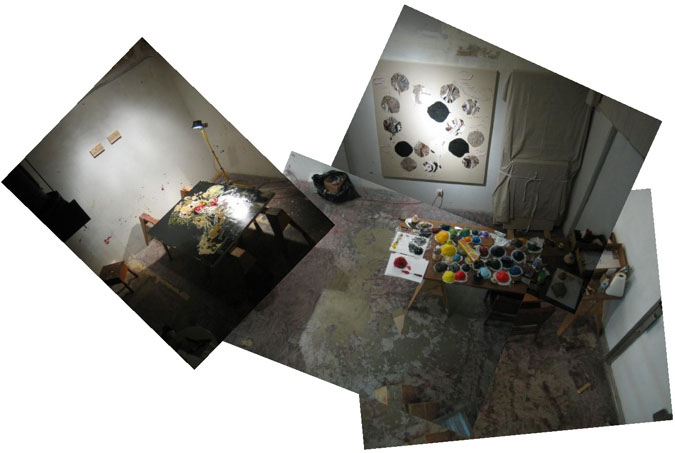
Around five am this morning, I snapped this and other fotos of a painting that I'm still full ov doubts about. I've scrapped it off a couple of times already, this might me a third.
I've spent most of the day catching up on my sleep and generally grousing about the scrape offs. I'm about to ride back down to ChinaTown and the probability is high that this one will be the third. And what does it look like? Usually, I tuck my low moments into the trash can in the corner of this computer screen. But what the hey. Check it out here and here. A little problematic is good. Too much is simply scrape off-able.
March 3, 2006
Wafa Sultan
In an update to the previous blogpost, I flagged the Memri clip from the Arab-American Psychologist Wafa Sultan on Al-Jazeera TV (Qatar). I found the transcript here. I thought it deserved a better presentation.
A snip:
Wafa Sultan: The clash we are witnessing around the world is not a clash of religions, or a clash of civilizations. It is a clash between two opposites, between two eras. It is a clash between a mentality that belongs to the Middle Ages and another mentality that belongs to the 21st century. It is a clash between civilization and backwardness, between the civilized and the primitive, between barbarity and rationality. It is a clash between freedom and oppression, between democracy and dictatorship. It is a clash between human rights, on the one hand, and the violation of these rights, on other hand. It is a clash between those who treat women like beasts, and those who treat them like human beings. What we see today is not a clash of civilizations. Civilizations do not clash, but compete.
UPDATE:
Looking at the Memri favorites, I read that Wafa Sultan is from L.A..
Cool.
Reading on, it's crystal clear that she's a soldier going deep.
The exchange is intense. Consider this finish:
Wafa Sultan: Can you explain to me the killing of a hundred thousand children, women and men in Algeria, using the most abominable killing methods? Can you explain to me the killing of 15,000 Syrian civilians? Can you explain to me the abominable crime in the military artillery school in Aleppo? Can you explain the crime in Al-Asbaqiya neighborhood of Damascus, Syria? Can you explain the attack of the terrorists on the peaceful village of Al-Kisheh in Upper Egypt, and the massacre of 21 Coptic peasants? Can you explain to me what is going on in Indonesia, Turkey, and Egypt, even though these are Islamic countries which opposed the American intervention in Iraq, and which don't have armies in Iraq, yet were not spared by the terrorists? Can you explain these phenomena, which took place in Arab countries? Was all this revenge on America or Israel? Or were they merely to satisfy bestial wild instincts aroused in them by religious teachings, which incite to rejection of the other, to the killing of the other, and to the denial of the other. When Saddam Hussein buried 300,000 Shiites and Kurds alive, we did not hear a single Muslim protesting. Your silence served to acknowledge the legitimacy of these killings, didn't it?...What do you want from me? To speak evil of the American society? I've never said that America is the eternal city of Plato, but I did say it was the eternal city of Wafa Sultan. The idealism of American society was enough to allow me to realize my humanity. I came to this country with fear.
Bin Muhammad:Along with the Indians? Along with the Indians? What was left of the Indians? What do you have to say about the Indians?
Wafa Sultan: Christopher Columbus discovered American in 1492. America was founded in 1776, approximately 300 years later. You cannot blame America ? as a constitution, a regime, and a state ? for killing the Indians.
Manifesto II
Together with the previous manifesto, this points to the possibility that Modern Muslms are distinguishing themselves from the atavistic ones.
A vital meme is spreading like a vaccine:
Don't be silenced by extremistsA plea from 11 Canadian Muslim academics and activists:
A curtain of fear has descended on the intelligentsia of the West, including Canada. The fear of being misunderstood as Islamophobic has sealed their lips, dried their pens and locked their keyboards.
Feb. 28, 2006. 10:37 AM
With hundreds dead around the world in the aftermath of the now infamous Danish cartoons, Canada's writers, politicians and media have imposed a frightening censorship on themselves, refusing to speak their minds, thus ensuring that the only voices being heard are that of the Muslim extremists and the racist right.Emboldened by the free rein they have received, Canada's Muslim extremists and their supporters flexed their muscles at Queen's Park last week, with speakers promising to drown the Danish people "in their own blood".
A protestor carried the sign "Kurt Westgaard - countdown to justice has begun ... it's just a matter of time."Elsewhere, in Pakistan, a Muslim woman was pictured carrying a sign, "God Bless Hitler," and a Muslim cleric placed a $1 million reward for the murder of a Danish cartoonist. Embassies were burned, churches ruined and hundreds died in different Muslim countries.
Undoubtedly, Muslims were angered by the insulting cartoons. But the overblown reaction was partly due to their pent-up frustrations, and partly the result of orchestrated mischief by certain Islamist leaders.
Islamic societies, run by variances of autocratic regimes, are in turmoil. Ravaged by rampant corruption, a widening gap between rich and poor, and suppression of dissent, the people in these societies have lost hope in their own futures.
The U.S.-led invasion of Afghanistan and Iraq, the unending occupation of the Palestinian territories and the quagmire of the Kashmiri dispute, have led many Muslims and non-religious peoples of Islamic origin, to view the West as the source of their countries' problems.
The growing popularity of the extremists in Muslim societies, the electoral success of the likes of Mahmoud Ahmadinejad in Iran, Shia radicals in Iraq, and Hamas in the Palestinian territories, rather than signifying the growing religiosity of the peoples of the Middle East, reflect political despair in the region.
In the West, people of Muslim origin, be they religious or secular, are facing growing racism, Islamophobia and discrimination reflected in immigration policies and anti-terrorist legislation.
The cartoon crisis was the straw that broke the camel's back.
The Muslim extremists seized the opportunity and added fuel to fire. The calculated role played by the two Danish Muslim extremists, backed by Islamic fundamentalist regimes, is a case in point. They not only aggravated an already inflammatory situation, but added their own infuriating images, never published in the West, as they took their case to clerics in the Middle East.Both, Imam Abu Laban and Ahmad Akkari have escaped the attention and scrutiny their acts deserved. These two men, who now sit in the comfort of their homes in Denmark, should be held accountable for their criminal actions.
For too long the media have created an image that portrays communities from the Muslim world as a monolith entity, best represented by extremists.The media have created a false dichotomy that pits these Muslim extremists against the West. The fact is that in all Muslim countries, progressive citizens are trying to break loose from the tyranny of the autocrats and clerics and wish to develop a civil society where citizenship is based not on inherited race or religion, but the equality of all, irrespective of faith, race, sexuality or gender.
In Tehran today, the city's bus drivers are on strike. Thousands have been arrested; entire families have disappeared. Yet, this has not made a blip in the western media.If the same bus drivers were burning books or embassies, this would certainly be on the evening news. This is an appalling example that only outrageous, violent expressions of faith by Muslim extremists are taken as the aspirations of people from Islamic societies.
It is time for Canadians to stand up for the hard-won democratic values that the Muslim extremists oppose.
By rejecting the agenda of the extremists, Canada's intelligentsia would be standing shoulder to shoulder with the Muslims and secular individuals from the region who reject both Islamophobia and Islamism. Islamism is not the new revolutionary movement against global forces of oppression, as a section of the left in this country erroneously perceives.
Today, the religious right and autocracies in the so-called Islamic world are united in their call for passing legislation to make any discussion on religion a criminal offence.
This, at a time when many writers in Jordan, Iran, Yemen, Pakistan and Afghanistan are rotting in jails, facing charges of apostasy and blasphemy.
We call on Canadian politicians and intellectuals to stand up for freedom of expression.
Our democratic values, including free speech, should not be compromised under the garb of fighting hate.
To fight Islamophobia and racism, we do not need to sacrifice free speech and debate.
The authors
Jehad Aliweiwi, former executive director of the Canadian Arab Federation.
Taj Hashmi, sessional professor, Simon Fraser University.
Amir Hassanpour, associate professor, University of Toronto.
Tarek Fatah, host, The Muslim Chronicle, CTS-TV.
Tareq Y. Ismael, professor, University of Calgary.
Jacqueline S. Ismael, professor, University of Calgary.
El-Farouk Khaki, secretary general, Muslim Canadian Congress.
Shahrzad Mojab, associate professor, University of Toronto.
Haideh Moghissi, professor, York University.
Munir Pervaiz, secretary, Pakistan-Canadian Writers Forum.
Saeed Rahnema, professor, York University.
(via Agora)
UPDATE:
Check this video out, via Instapundit and Memri.org. Wafa Sultan is such a courageous woman! It's great to hear that in her voice. It's worth noting that this epic fight for freedom in the Muslim world is led by women.
YES
"The West is, and shall remain, one," Berlusconi said. "We cannot have two Wests. Europe needs America and America needs Europe." The line brought a standing ovation.
(via Eric Savane's No Pasar?n)
Can Artists Ever Truly Be Modest?
As I like to say: Temerity is an occupational hazard for artists.
Check this out:
Among the virtues commonly attributed to artists, modesty, it can confidently be said, is not to be found. In their professional capacity, painters and sculptors may be described as ?visionary,? ?innovative,? and the like. As human beings, however, they are almost always spoken of in pejorative terms. As Rudolf and Margot Wittkower observe in their 1963 book, Born Under Saturn: The Character and Conduct of Artists, ?There is an almost unanimous belief among [laymen] that artists are, and always have been, egocentric, temperamental, neurotic, rebellious, unreliable, licentious, extravagant, obsessed by their work, and altogether difficult to live with.? They might have added ?vain.?
Born Under Saturn.... a good title...
March 2, 2006
Videos Online
Two offerings for your perusal:
1. Doug Henders sent a link to the 50 "greatest" videos of 2005. A backlink takes us to an interesting music blog:About DoCopenhagen
The idea of creating DoCopenhagen came up in the spring of 2000. Our website started out as a "where to go" guide for Copenhagen but has over the years developed into an alternative music blog.
Although the bloody knife logo disturbs me a bit... I guess that was the point.
And..
2. Tom Moody pointed towards this crazy video archive site, wimp.com.... This rabbit hole will absorb your attention for hours. My favorite video: Counter Strike. (I guess you have to be intimately acquainted with cs_italy to appreciate it fully.)
March 1, 2006
Fade In
I'm blogging a friend's first reading for a recently created sceenplay. He asked me not to describe too much but fotos are ok. Too bad, I'd like to paste in a snip of the dialog along the way.
(So... there's nothing to blog, is there, Dennnis? Uh, yea.)
Well, maybe I'll only get to shoot pics leading up to the actual read. I cna't foto blog and read my part at the same time. Or blog anything that has a blackout
Yet.
Here goes....
"This is not a presentation... it's not a 'thing' yet, it's a half finished painting."
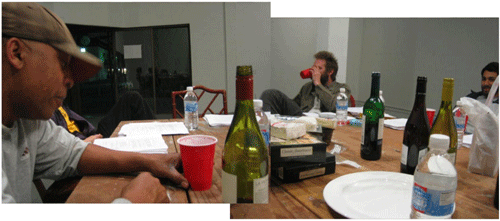



Big Day Saturday in ChinaTown

Henry TaylorHenry's going to open a solo show this Saturday at Sister Gallery here in ChinaTown. He shows at Katie Brennan's Sister Gallery. He's a great man and a great painter, I can't wait to see the show.
Get Black
March 4th - April 8th, 2006opening reception:
Saturday, March 4th, 7-9 PM
Also, that night is a group show curated by Andrew Hahn:
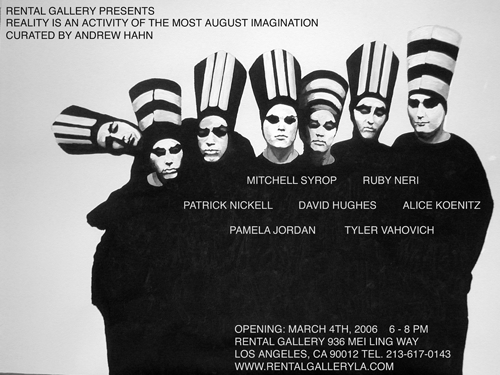
RENTAL GALLERYI asked Andrew if the title came from Camus, the image from "The Stranger" (...working from memory, am I right about this?). No, he said it was from Wallace Stevens. So, I Google and the first listing was Wikipedia on Wallace Stevens:
936 MEI LING WAY
CHINATOWN, LOS ANGELES, CA 90012T 213 617 0143 E rentalgallery@gmail.com
Imagination and Reality(I didn't get a chance to follow the thought to Camus. More on that later.)
Stevens is very much a poet of ideas. ?The poem must resist the intelligence / Almost successfully,? he wrote. His main ideas revolve around the interplay between imagination and reality and the relation between consciousness and the world. In Stevens, "imagination" is not equivalent to consciousness, or "reality" to the world as it exists outside our minds. Reality is the product of the imagination as it shapes the world. Because it is constantly changing as we attempt to find imaginatively satisfying ways to perceive the world, reality is an activity, not a static object. We approach reality with a piecemeal understanding, putting together parts of the world in an attempt to make it seem coherent. To make sense of the world is to construct a worldview through an active exercise of the imagination. This is no dry philosophical activity, but a passionate engagement in finding order and meaning. Thus Stevens could write in "The Idea of Order at Key West,?
Oh! Blessed rage for order, pale Ramon,
The maker's rage to order words of the sea,
Words of the fragrant portals, dimly-starred,
And of ourselves and of our origins,
In ghostlier demarcations, keener sounds.
It should be a good night. See you there!
PS: Also, Friday at Black Dragon Society, opens Raffi Kalenderian. I haven't seen his work yet but the word in these streets is that he's doing great paintings. there's much anticipation right now, maybe too much.
Alberto's Recent Paintings
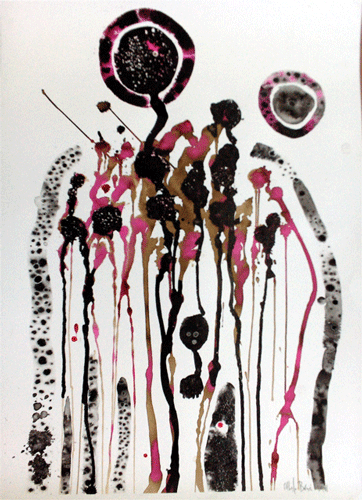
You might remember Alberto, my young artist friend from Tossa.
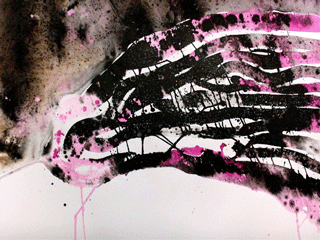
hi dennis I hope this time you?ll have recieved my photos.(He's planning some highjinks in Barcelona, artworld-wise)
tell me what do you think about it, I?m painting quite often, sometimes everyday, but at least I?m coming to the studio, here I think about new paintings, and I can tryout the ideas that come to my crazy brain.
the studio is near your house, well it isn?t really an studio it?s a room in the old school up on the hill near your barrio, but until I?ll have the money to build my studio at home its good to be here without having to pay for it, it?s quite big and I have wi-fi, I feel confortable here...................
I have already recieved your mail, thanks.
the other day I phoned my frends in barcelona and we are going to have a meeting soon as possible.
about going to Berlin... it?s the first time I had this feeling of having to paint everyday and I don?t want to change it. I?ll be in Tossa for a while, but of course that I?ll go to Berlin soon as it is possible too.
I?ll send you more with a picture of that place.
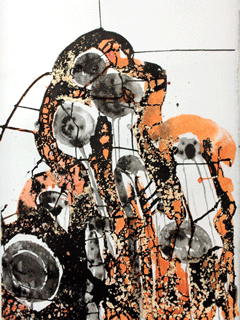
And I'll post it here in the blog of course.
That's the best feeling in the world, of having to paint every day.
JOHN PILSON: COLISEUM
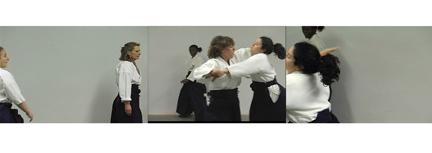
I wish I could be in New York this coming weekend to visit John Pilson's opening.
(All the best to you, John!)
Here is the press release:
March 4 - April 1, 2006Reception: Saturday, March 4, 6-8 p.m.
----------------------------------------------------------------------------------------
Nicole Klagsbrun Gallery is pleased to present, Coliseum, a solo exhibition of videos by John Pilson, running from March 4 until April 1, 2006. A reception for the artist will be held on Saturday, March 4, from 6-8 p.m.
Coliseum consists of four video works that explore the shifting relationships between work and play, talk and action, the daily and the dramatic. It is a clear-eyed picture of groups of friends, colleagues and co-workers coming together in a communal forum. Language and rhythm are constants in each piece, as men discuss arcane knowledge and women fight. Pilson has installed each work in a deliberate way, forcing each piece into conversation with the others. While previous work has been about the theatricality of space, these new works cinematically examine the nature of a group portrait.
A simple conversation about sports unfolds into a meditation on memorabilia, male intimacies and shared languages in Sunday Scenario, a three channel video depicting three men recalling and debating baseball?s greatest moments. The spaces and circumstance (an office, a suburban forest, a master bedroom) of each participant tell a different story. Their opinionated discussion rises and falls, as small pictures pop up on screen, illuminating the person or place under discussion.
One woman fends off a multiple person attack in Rondori, a traditional Aikido sparring exercise. Each black-belt aggressor moves through a space extended by multiple (and simultaneous) camera view points. The combatants exchange blows with balletic precision while the punishing thuds of bodies and strenuous breathing belie their easy movement.
In Wisdom and Charisma, a group of middle-aged men, who used to play Dungeons and Dragons twenty years ago, meet after work for a session of the role-playing game. Seated around a corporate boardroom table, the Dungeon Master, dressed in red, leads the others in debating pathways through astral planes and portals of pandemonium while stationary, control room-like, cameras allow for the reactions and silent exchanges between the players to be fully scrutinized. Their clothes and body language indicate their executive occupation and social standing, a strong contrast to their adolescent pastime.
Seven British (and one Canadian) actresses give an impromptu (and improbable) performance of the opening monologue from David Mamet's GlenGarry GlennRoss in The London Cast. Through editing, each performance is blended into a single monologue. The harangue of the salesman is spread across the seven voices while the various interpretations and acting styles suggest competitive performances within a play about competition.
Pilson?s work has a realism that avoids romanticism, sentimentality or nostalgia in favor of an emotionally neutral and objective view. These works beautifully illustrate Pilson's thoughts about the nature of discussion and confrontation, while underscoring the humanism inherent in all of his work.
John Pilson lives and works in New York City. This is his third solo show with the gallery. Previously, his work has been included in Premieres, at the Museum of Modern Art, New York in 2005; in Moving Pictures at the Guggenheim Museum, New York; in The Americans? New Art, at the Barbican Gallery, London in 2001; and in Greater New York at P.S.1 in 2000. He was the recipient of the B?loise Prize for Art Statements at the 2002 installment of Art Basel in Switzerland. He has also received the Young Artists Special Prize at the 49th Venice Biennale in 2001. His work has been accessioned into numerous public collections.
For more information or images, please contact the gallery at 212.243.3335 or email gallery@nicoleklagsbrun.com.

